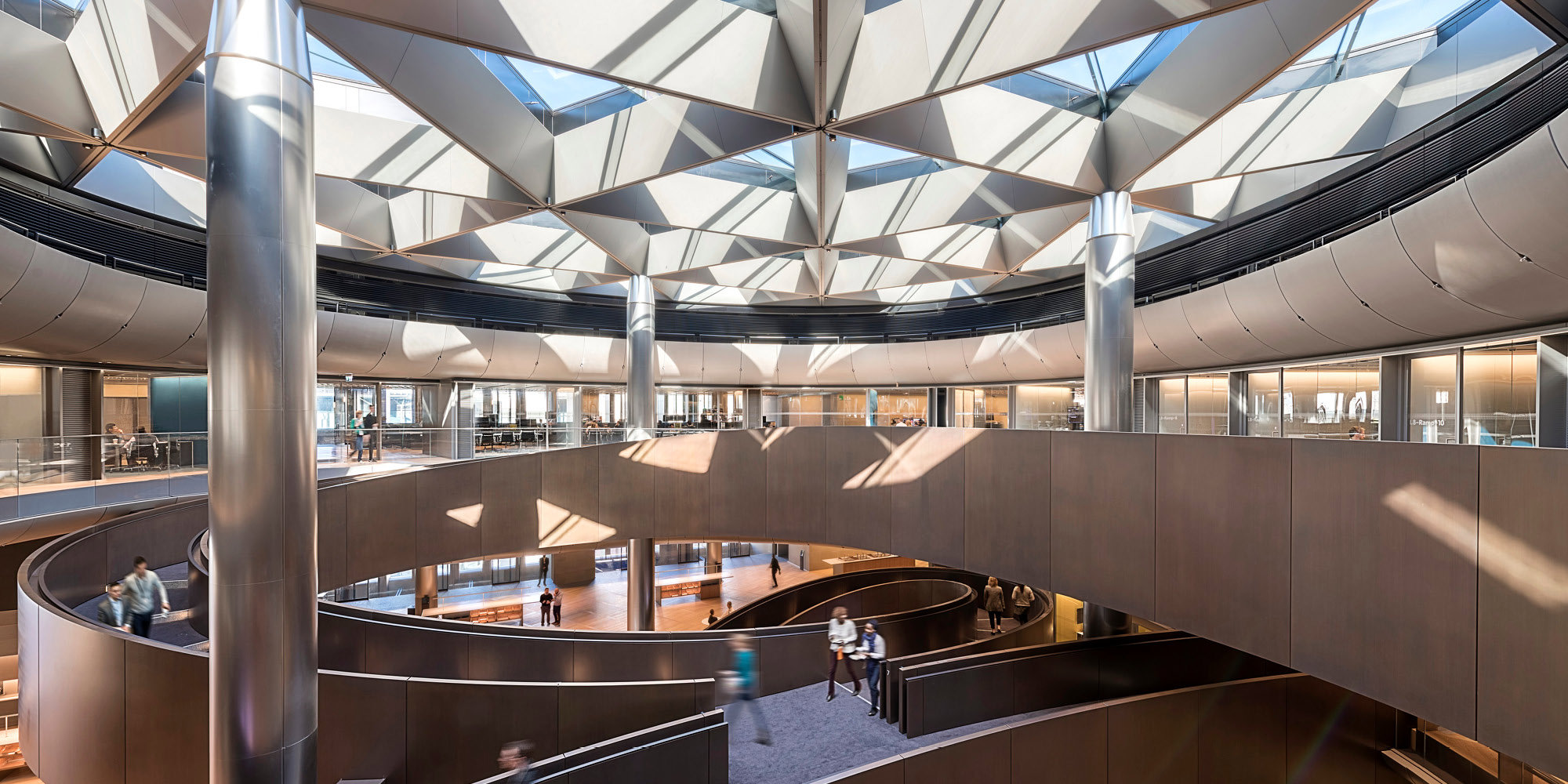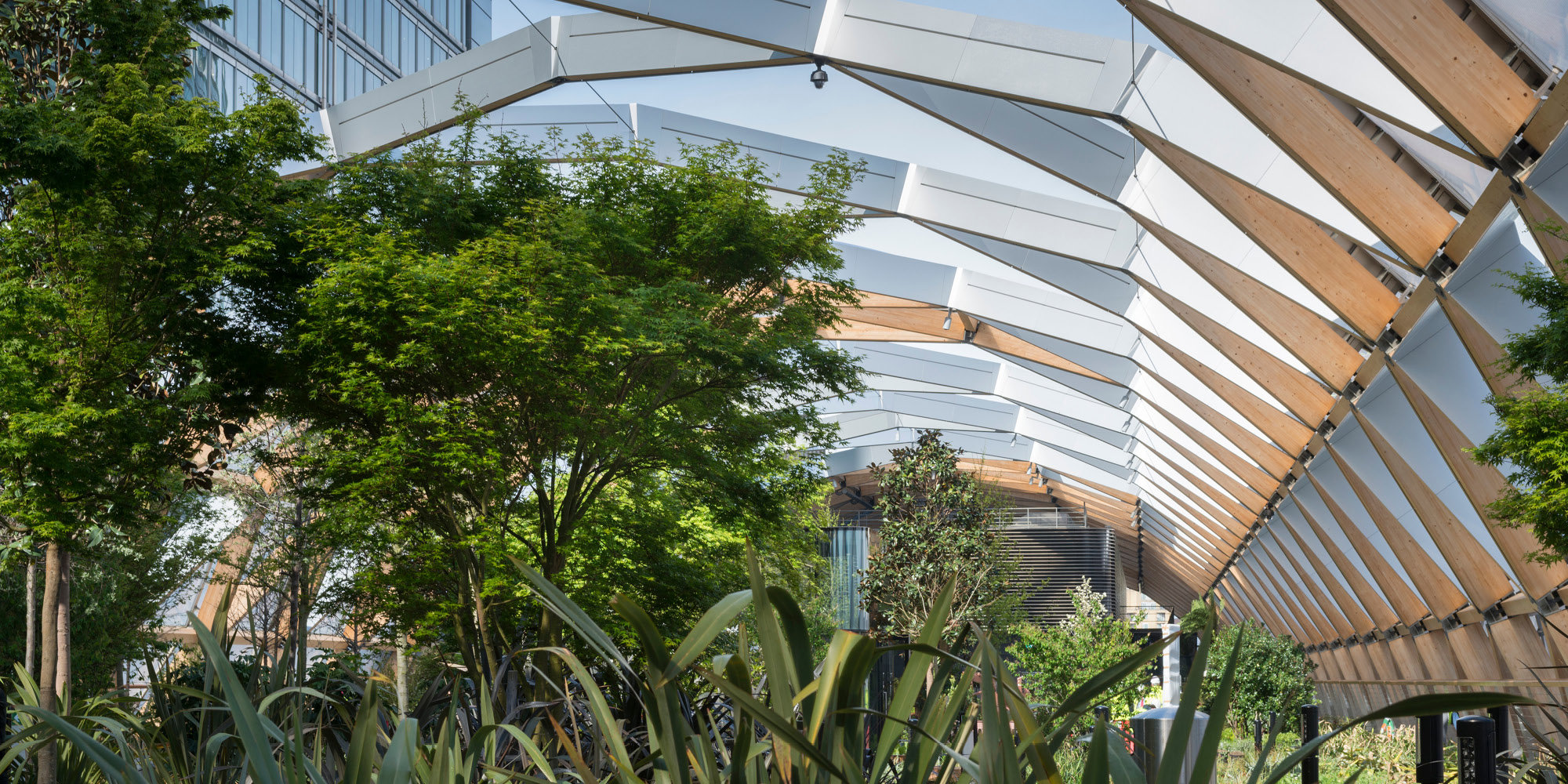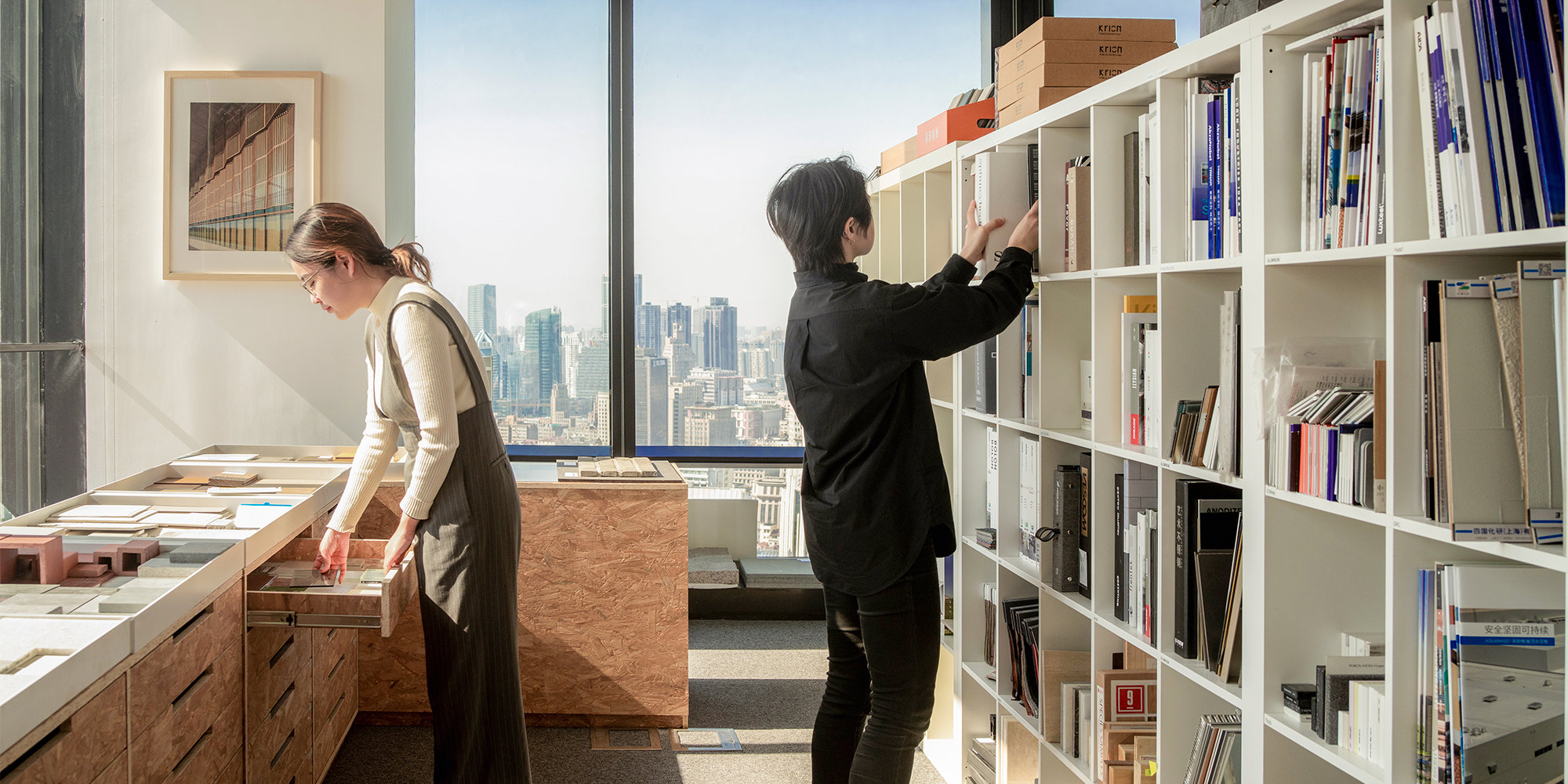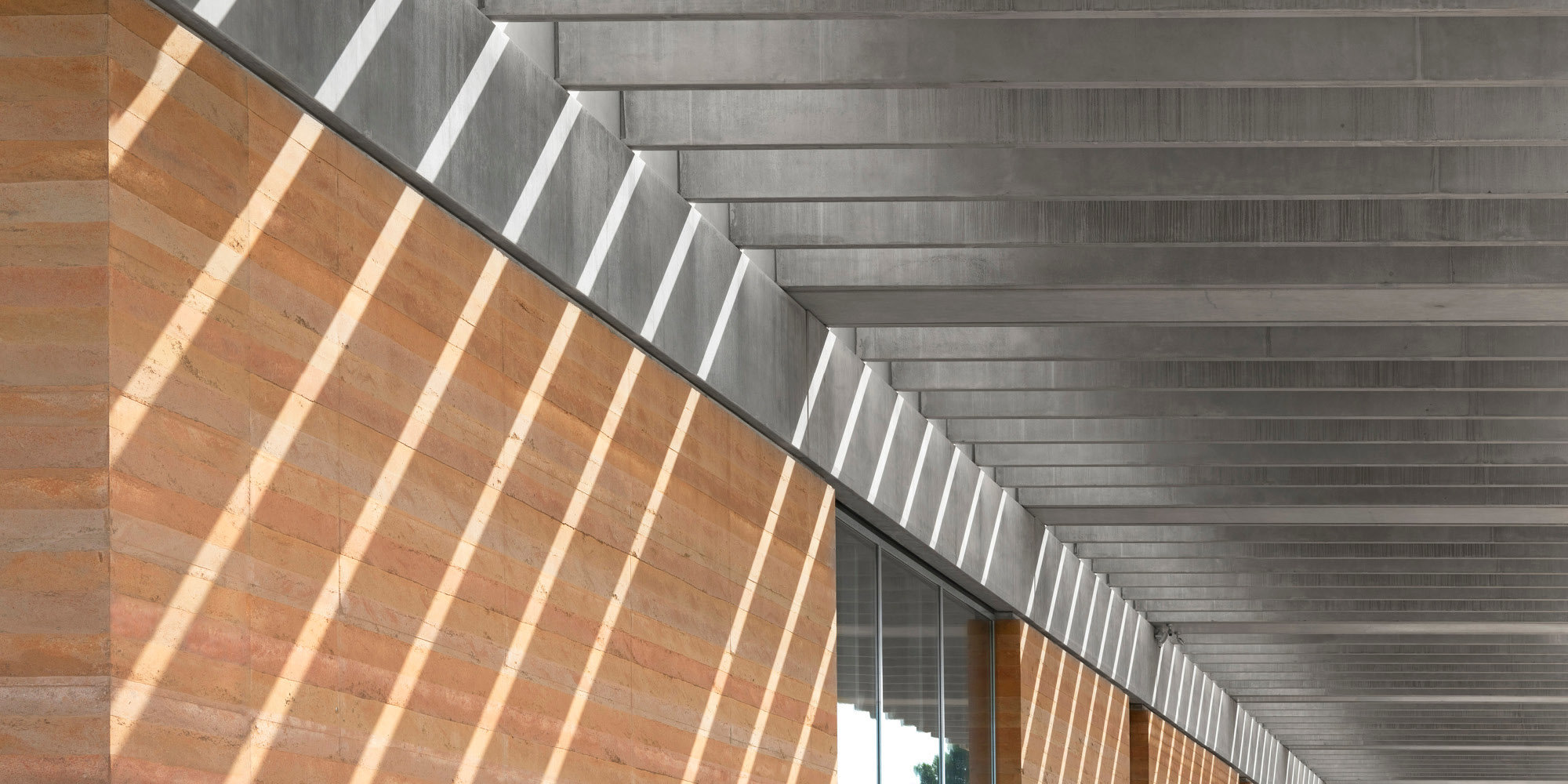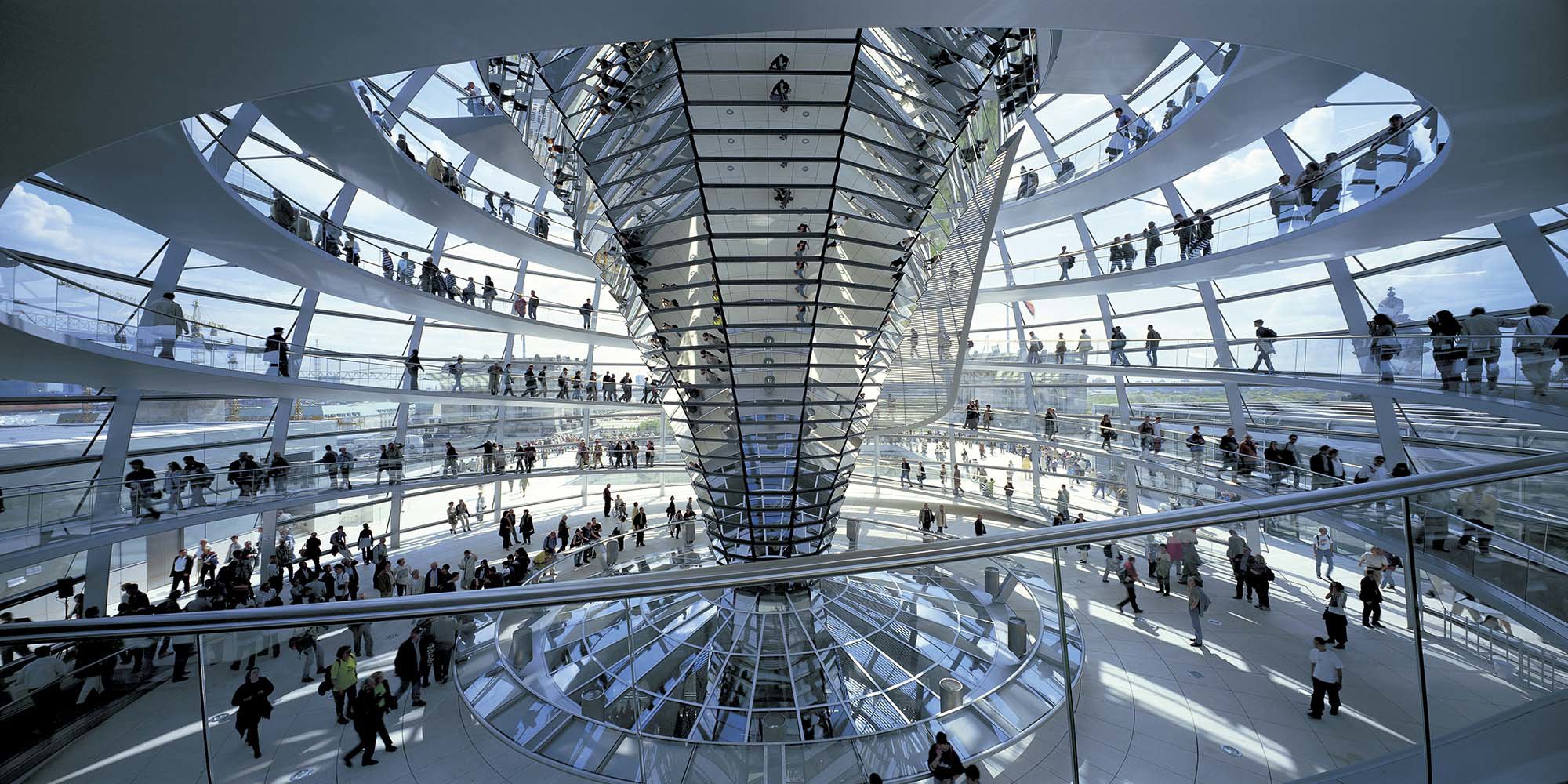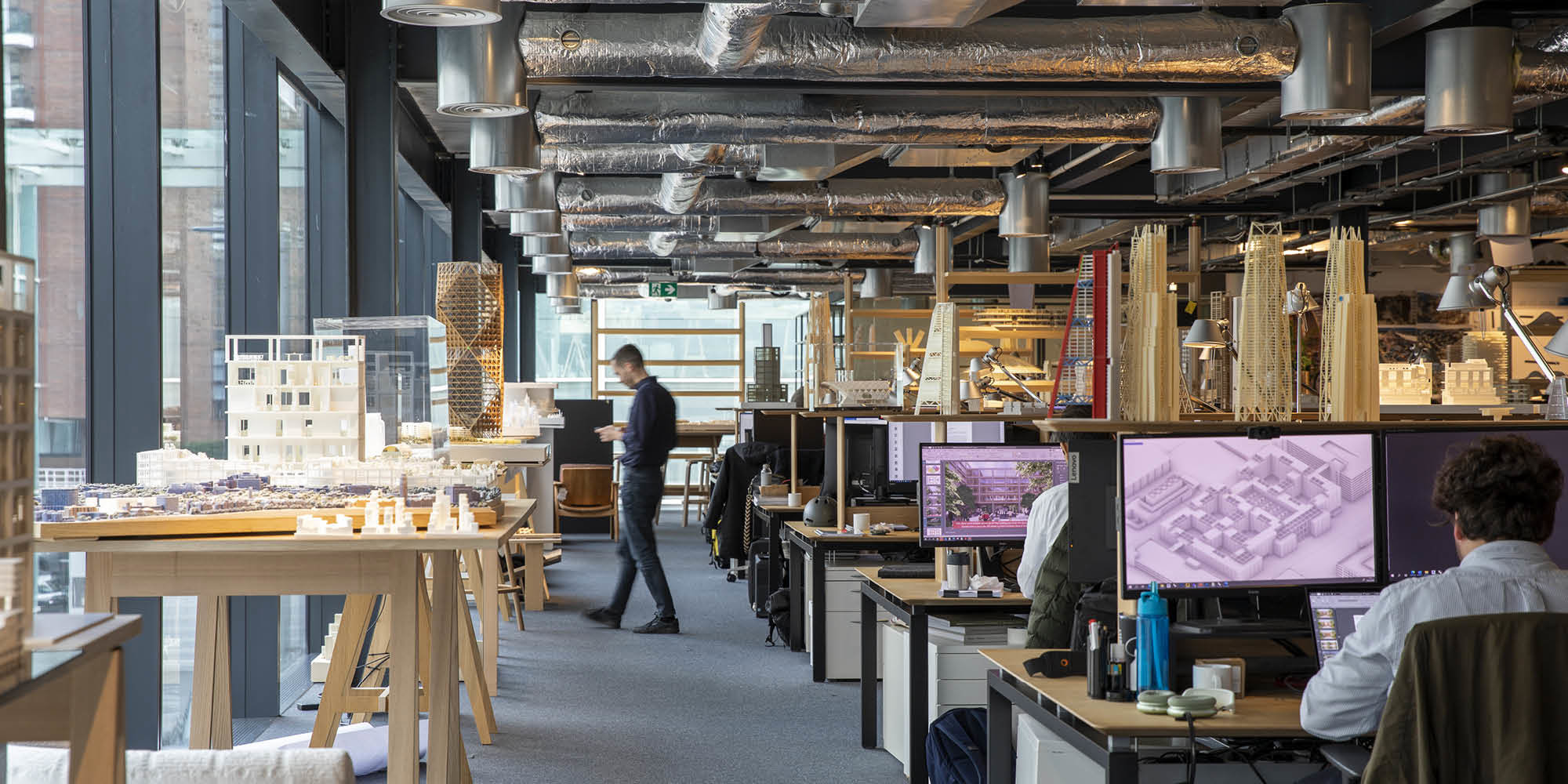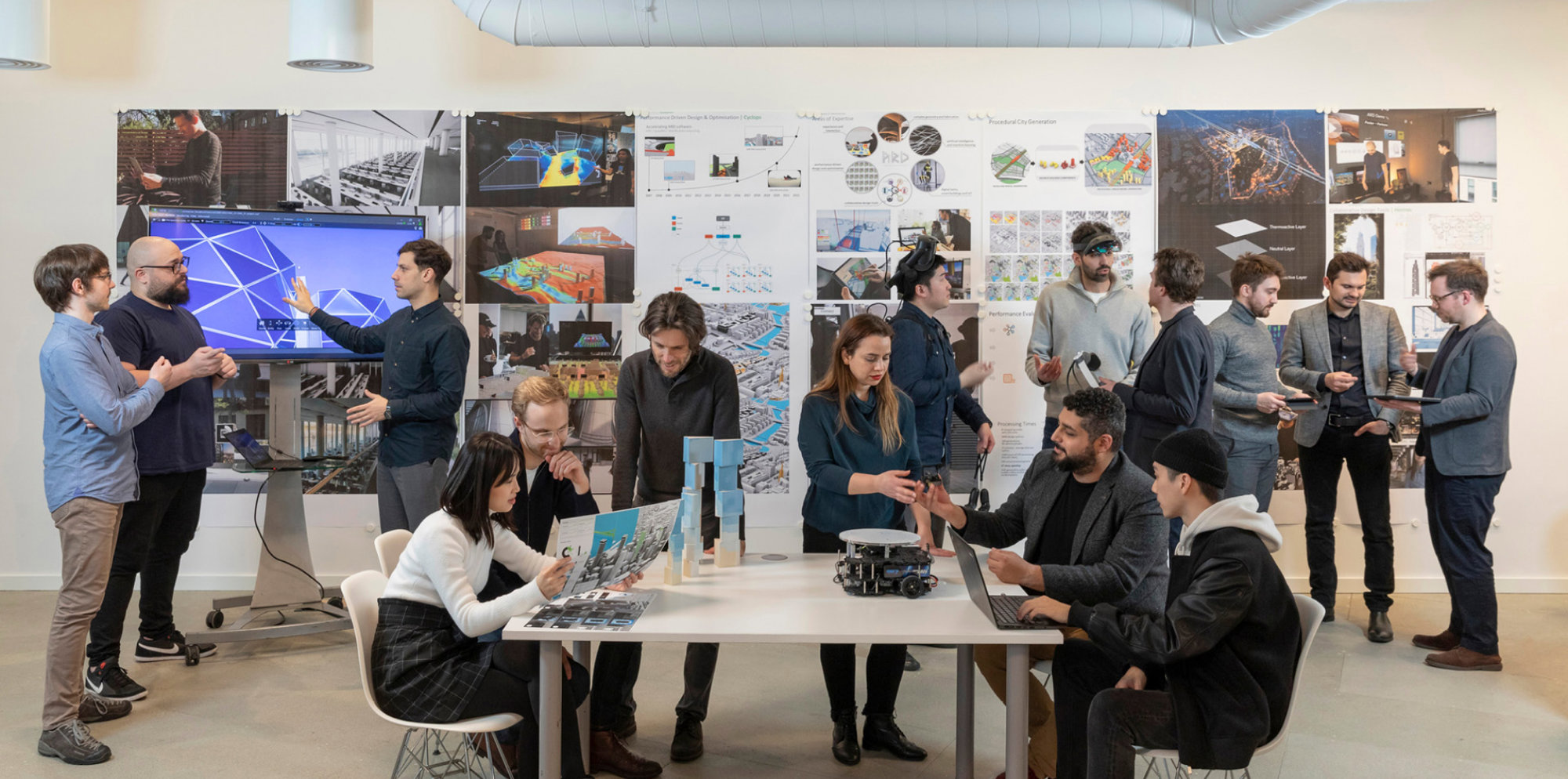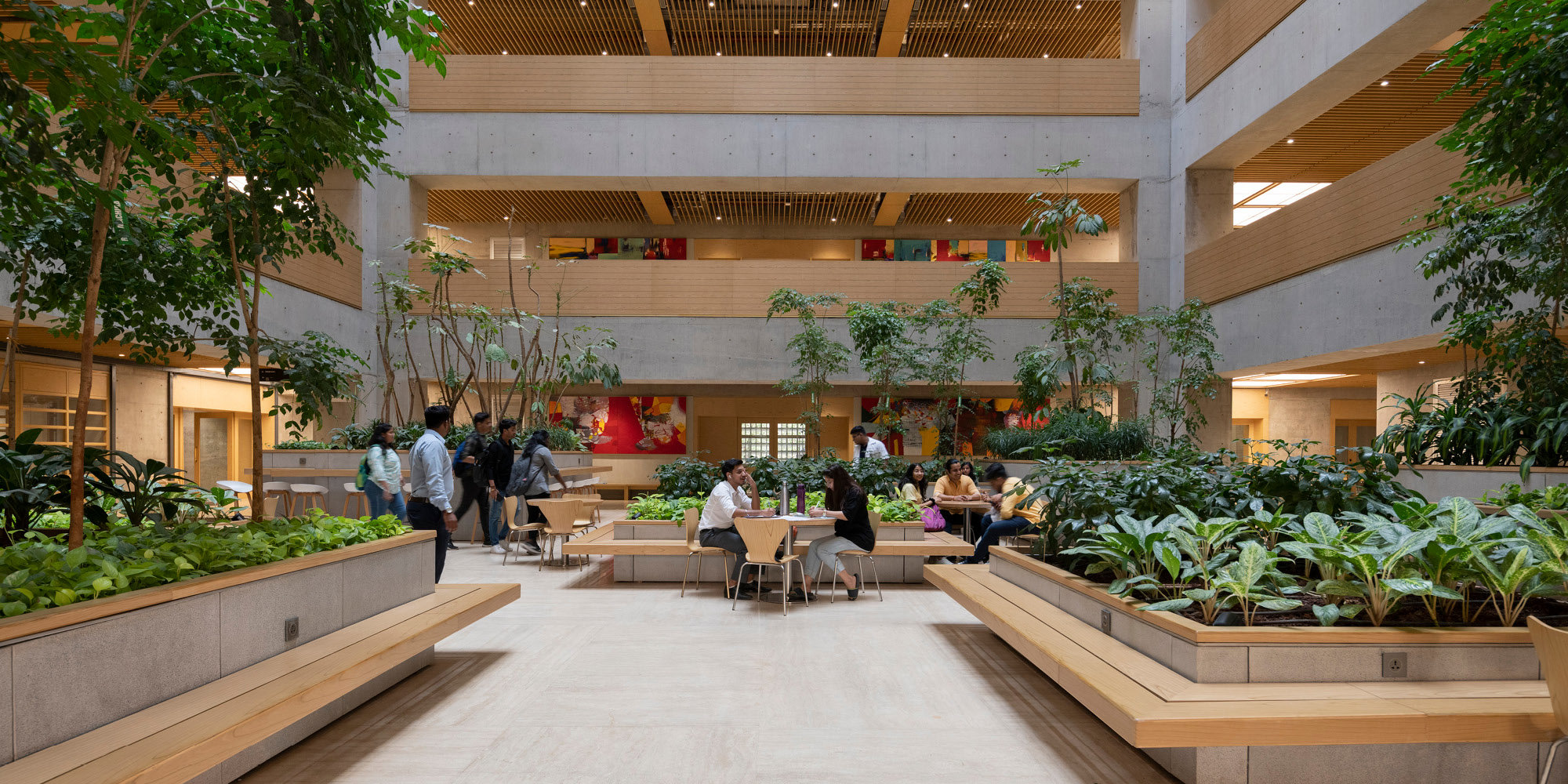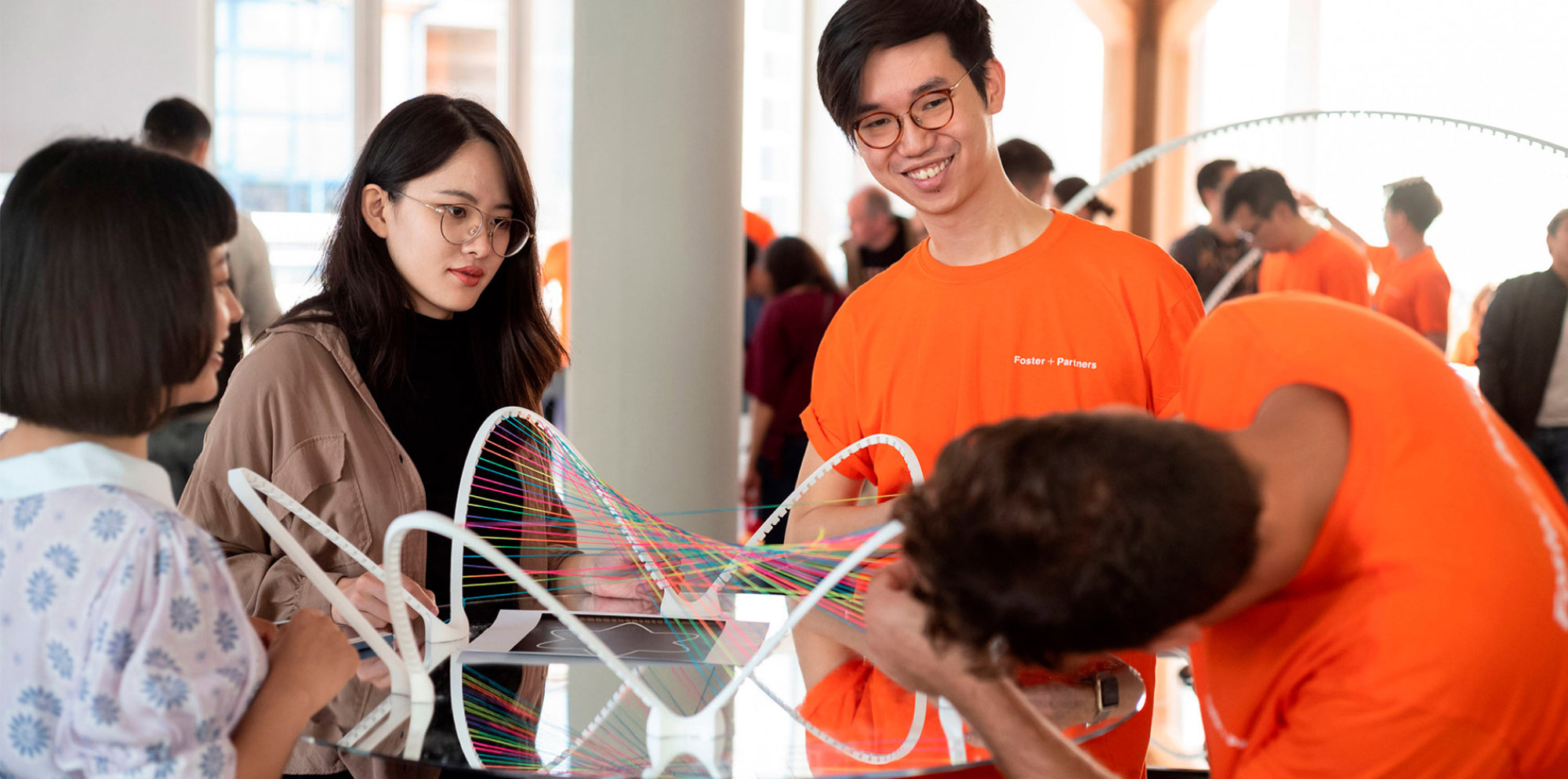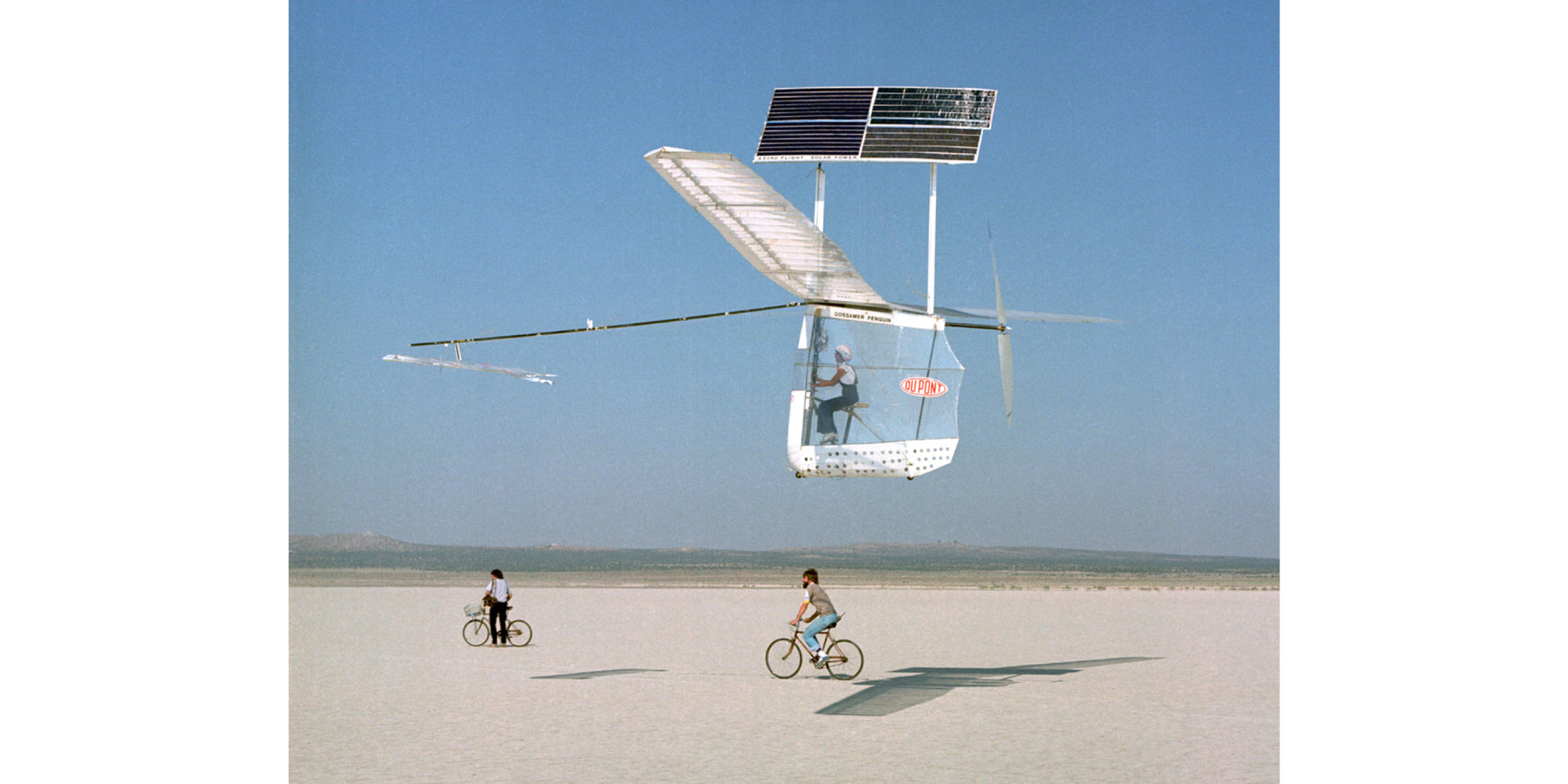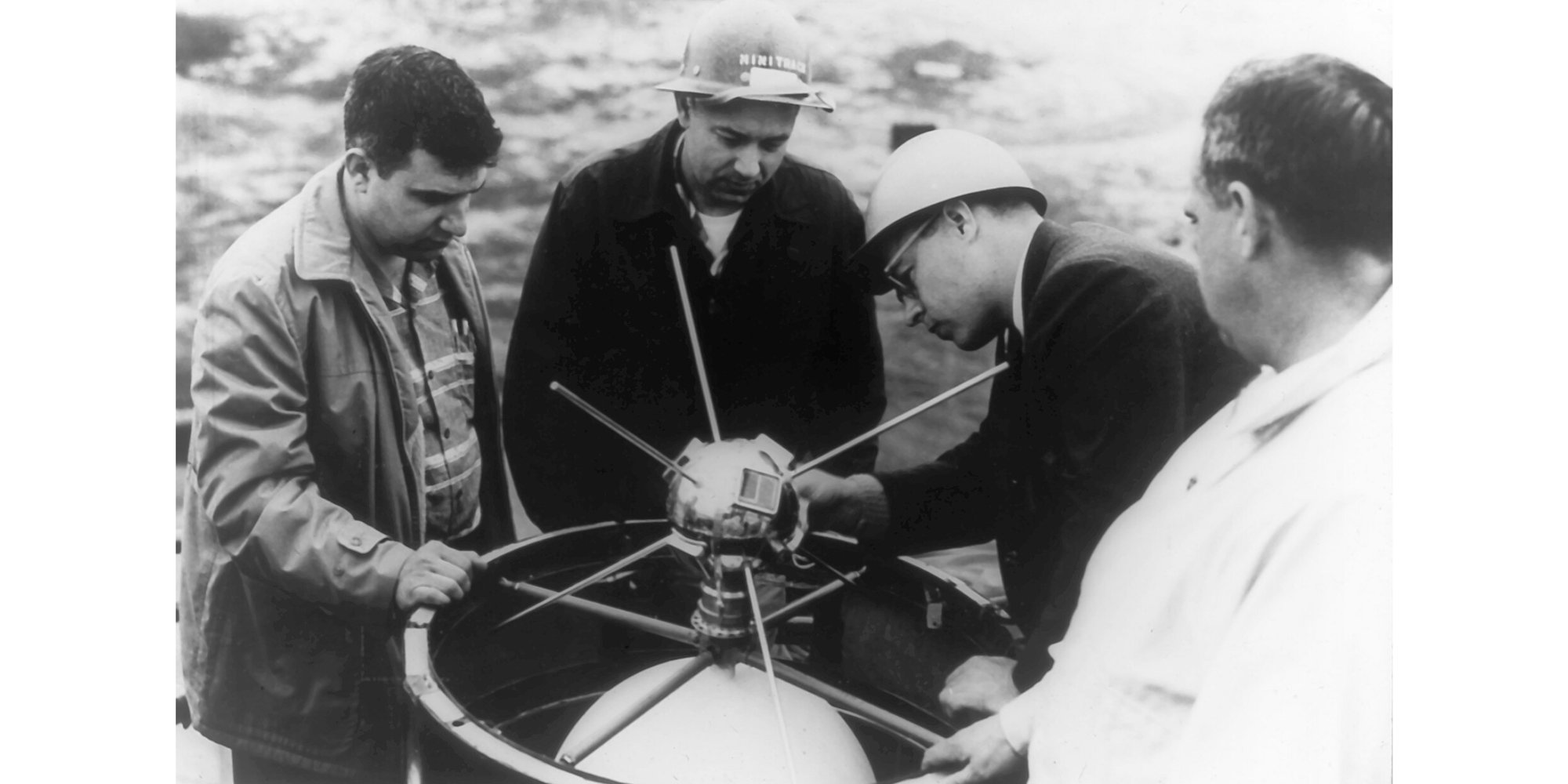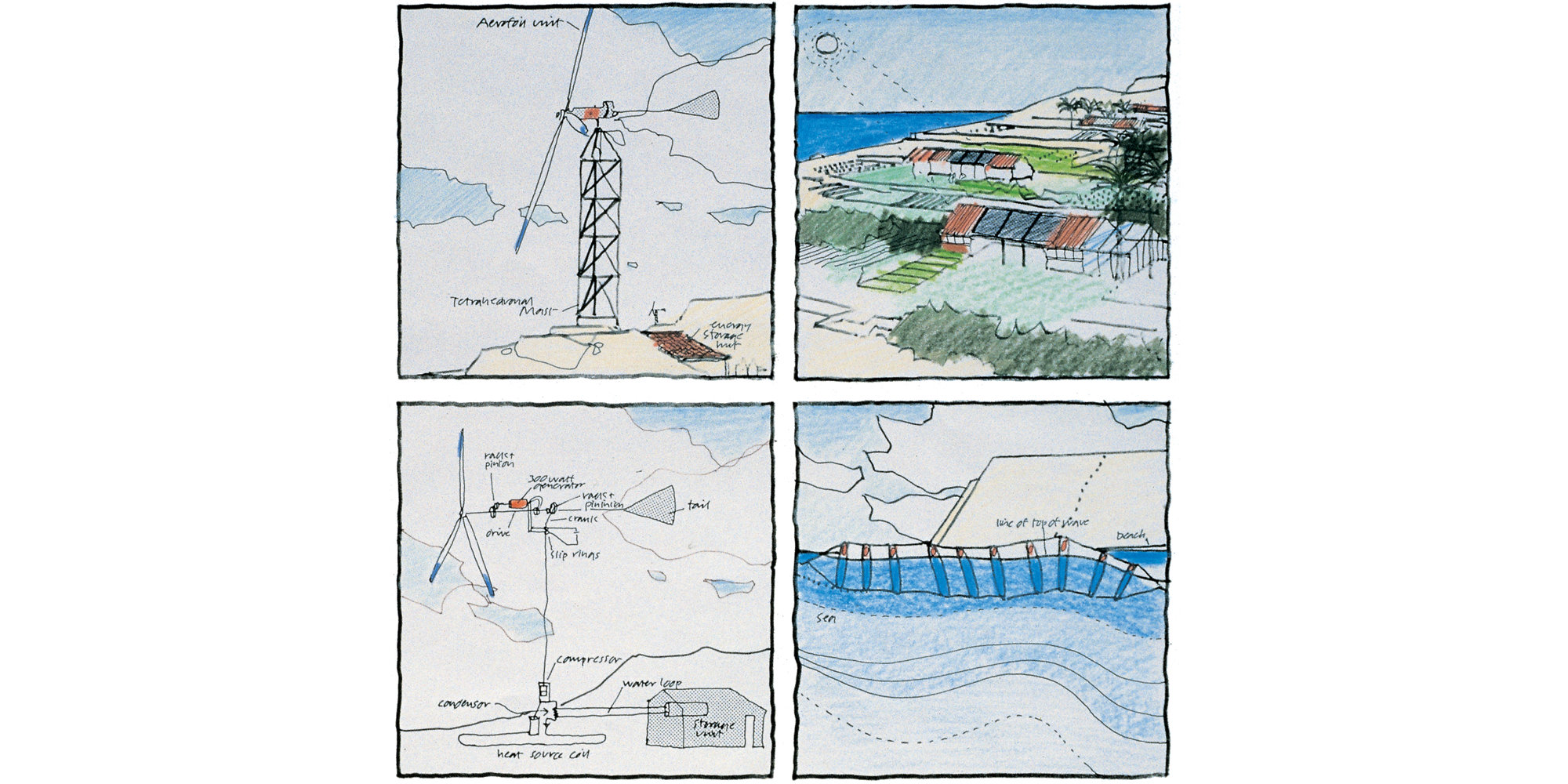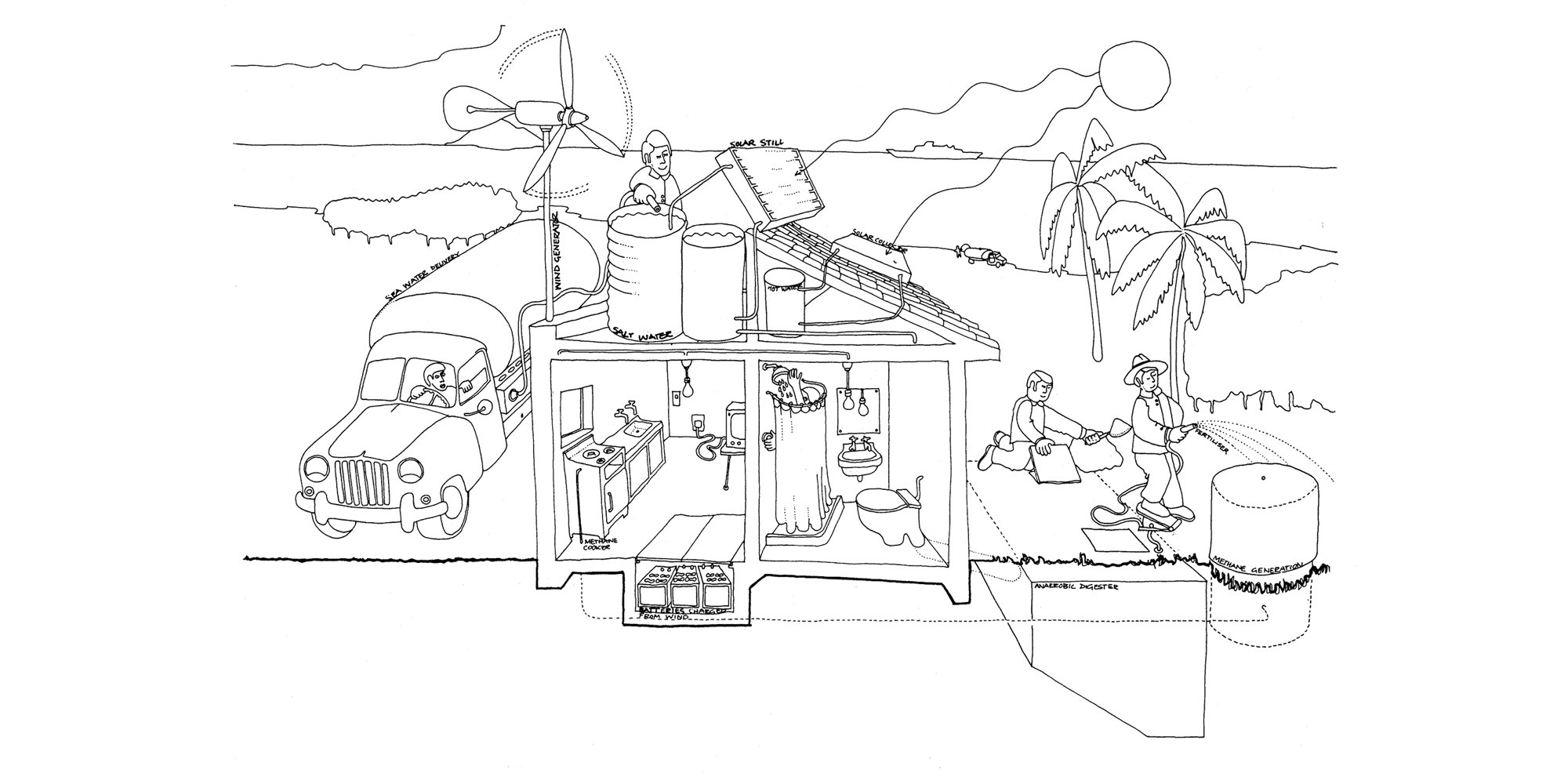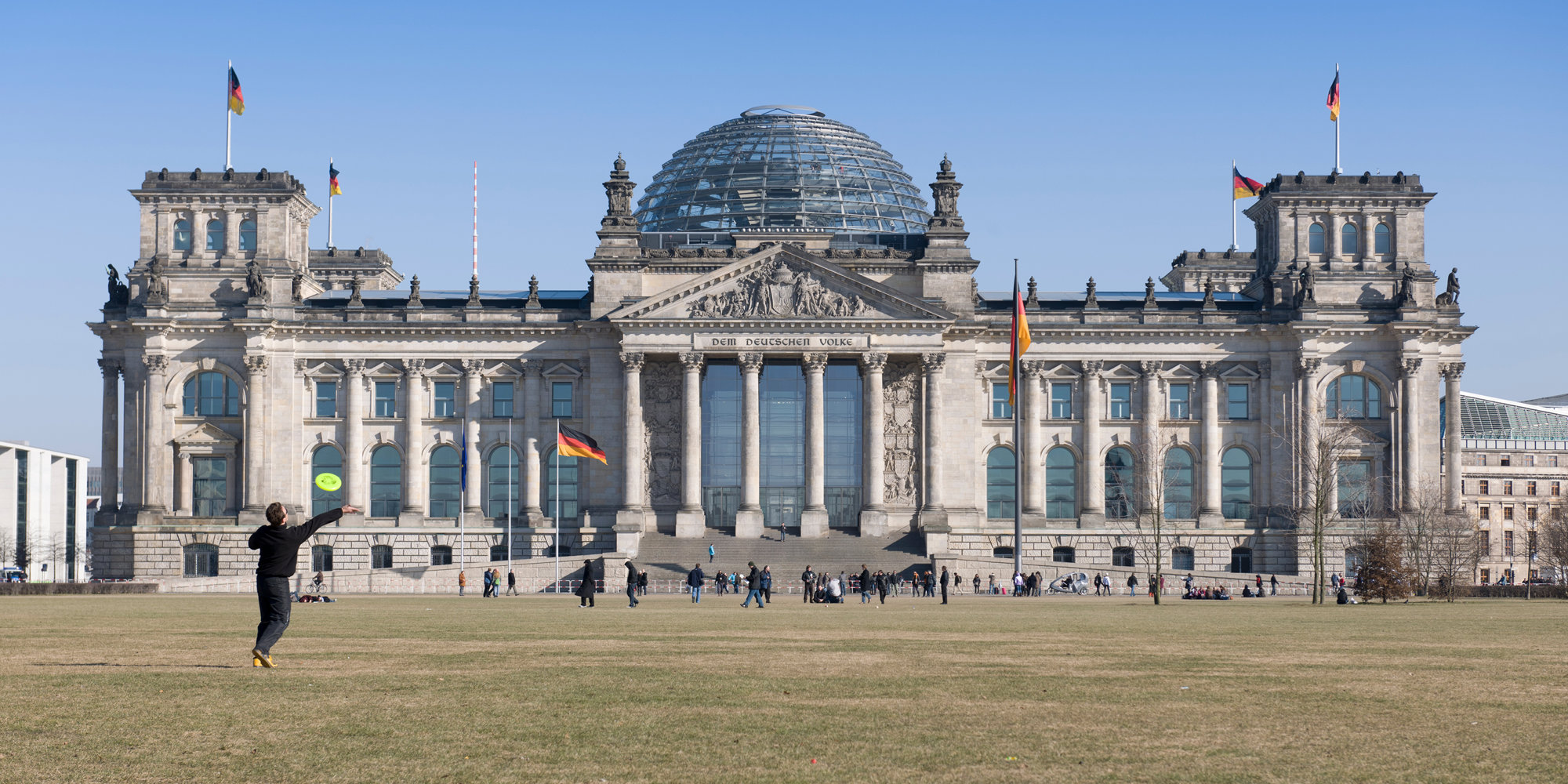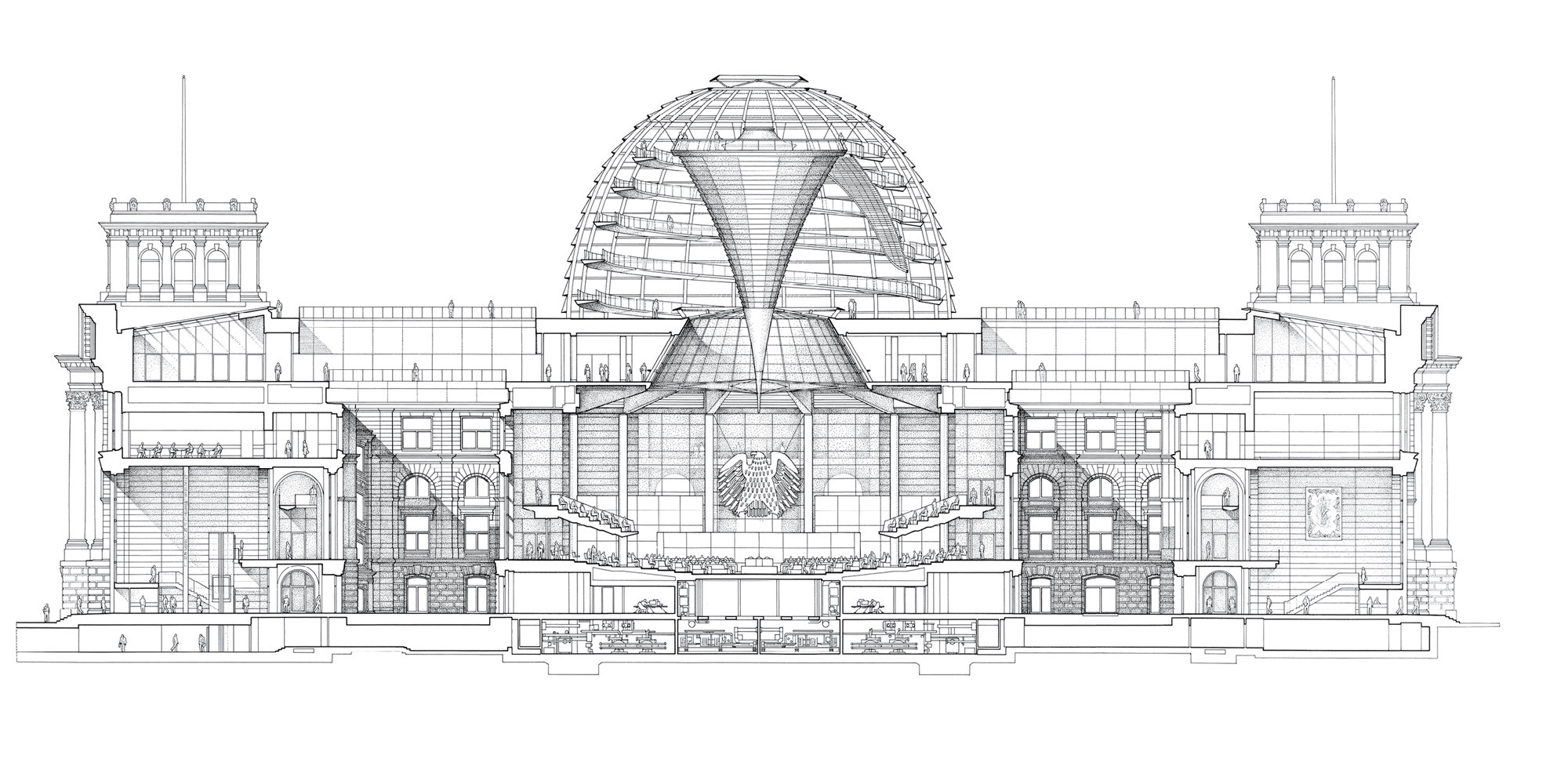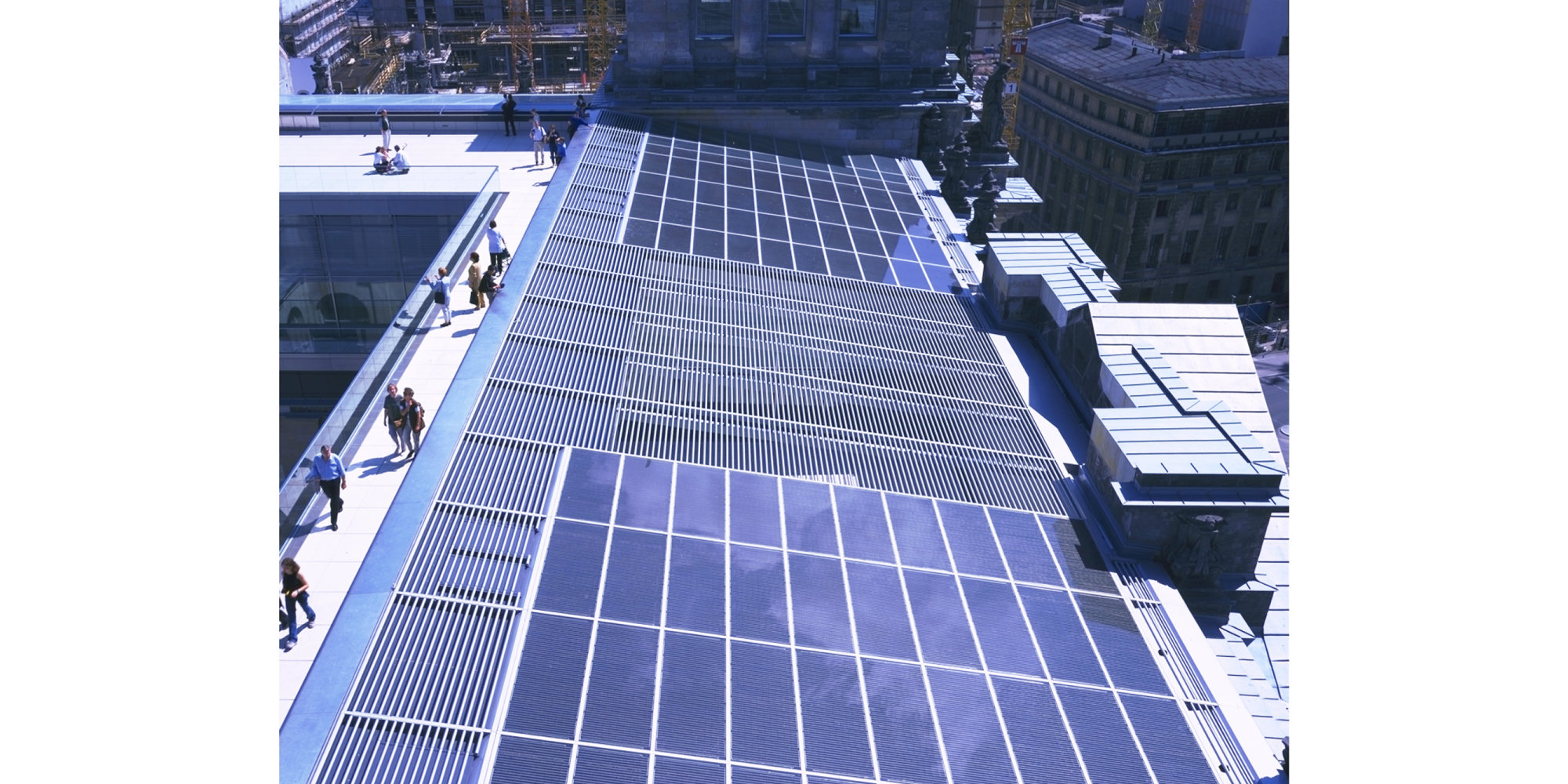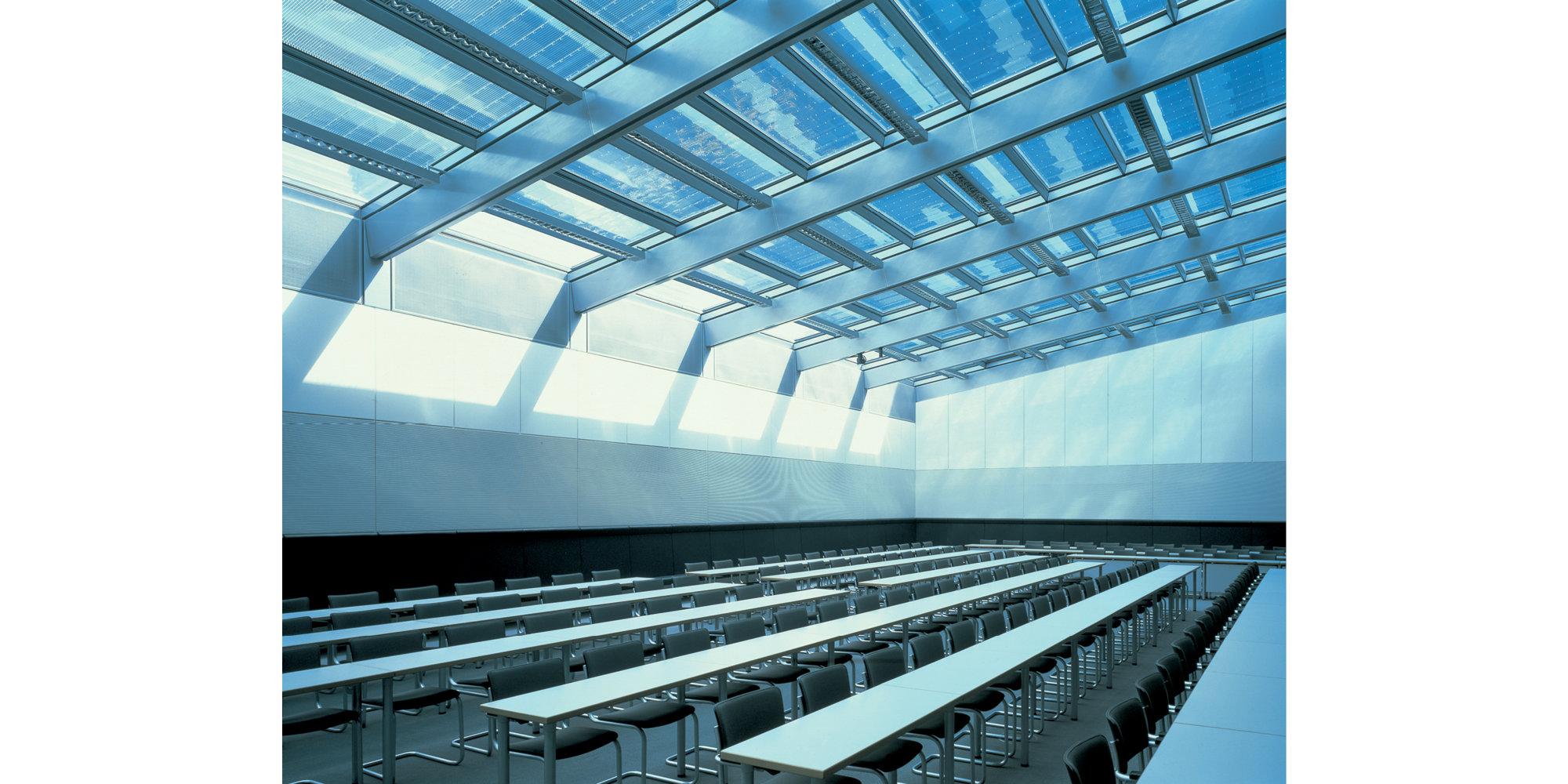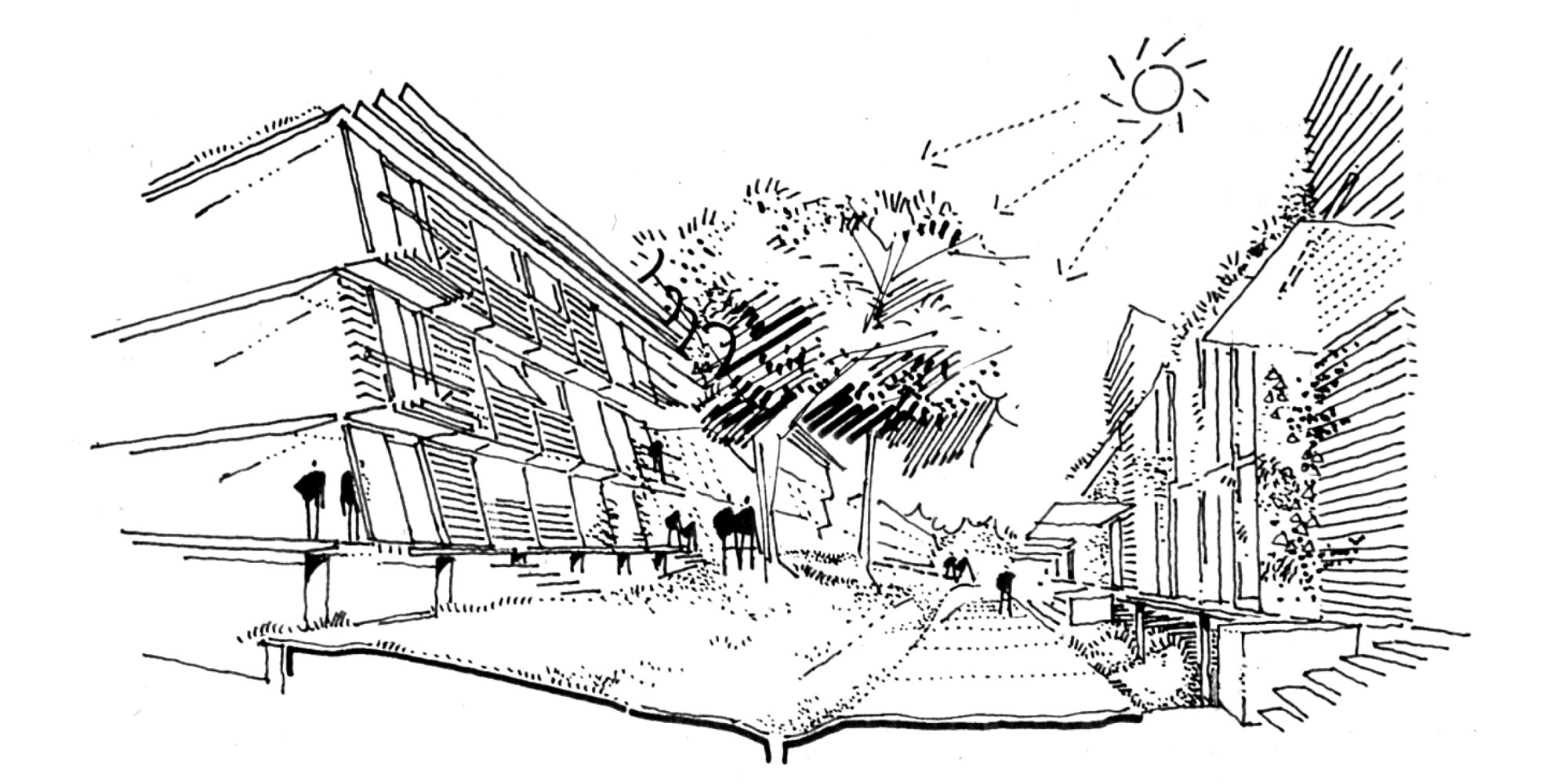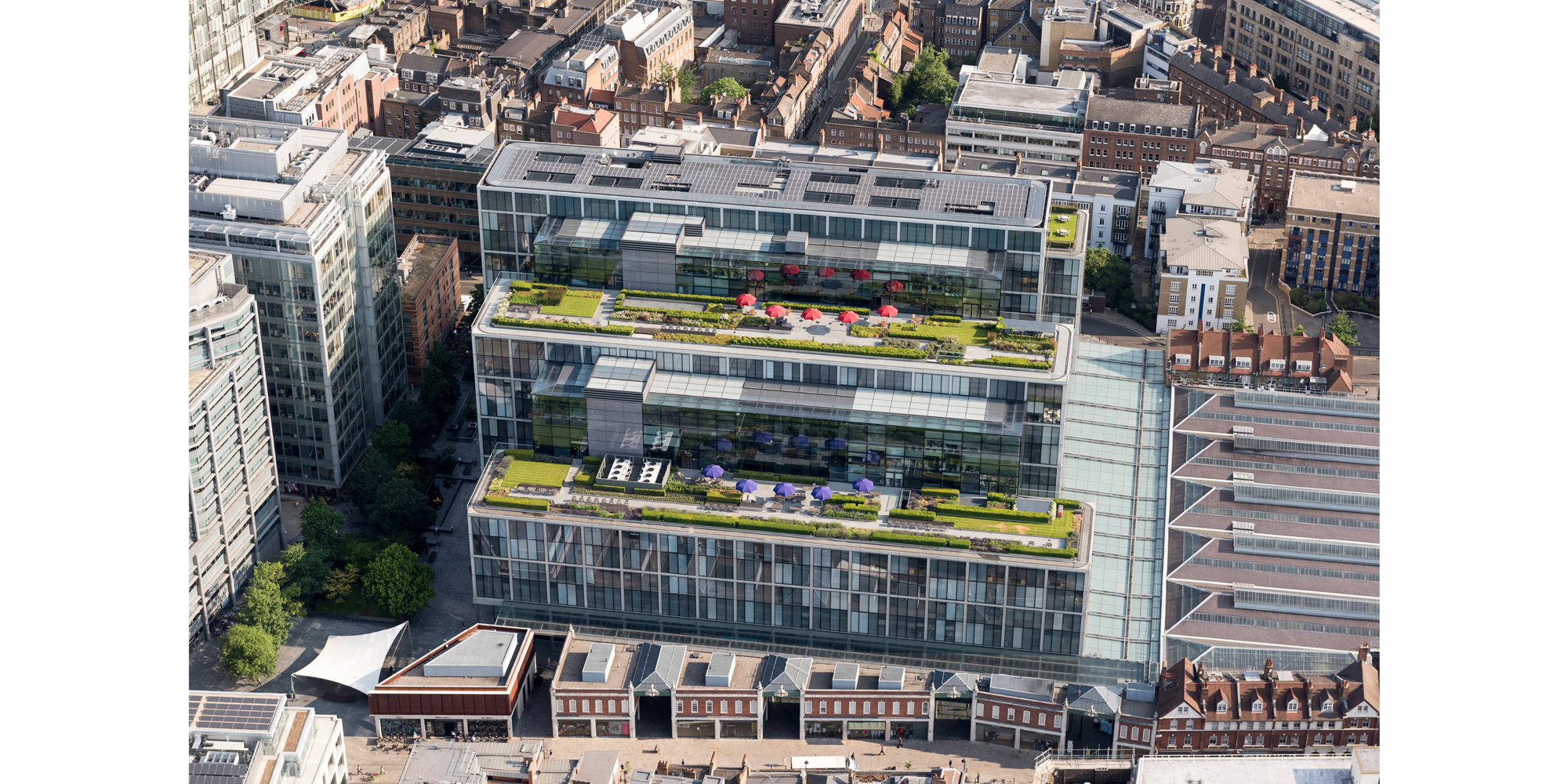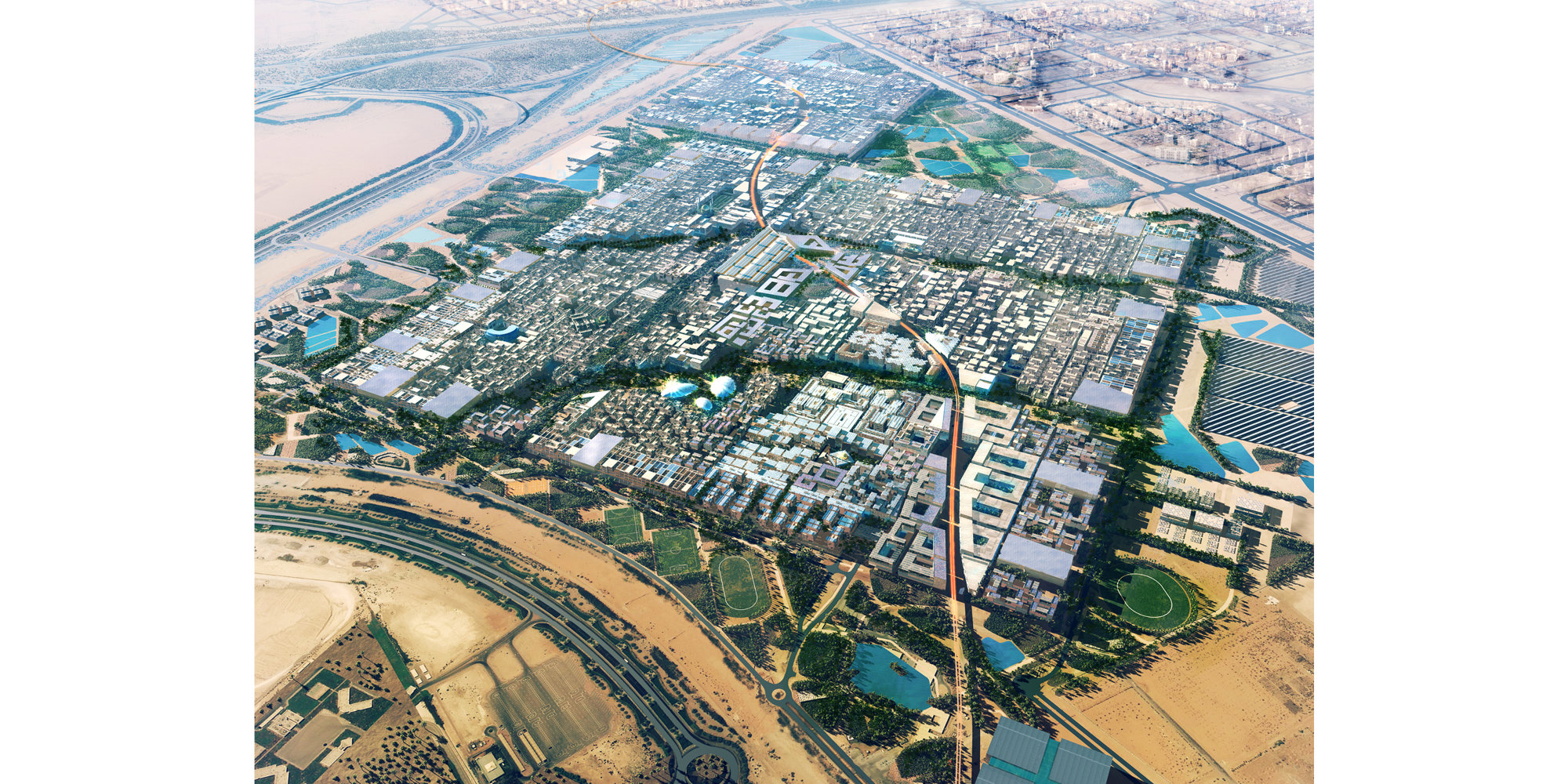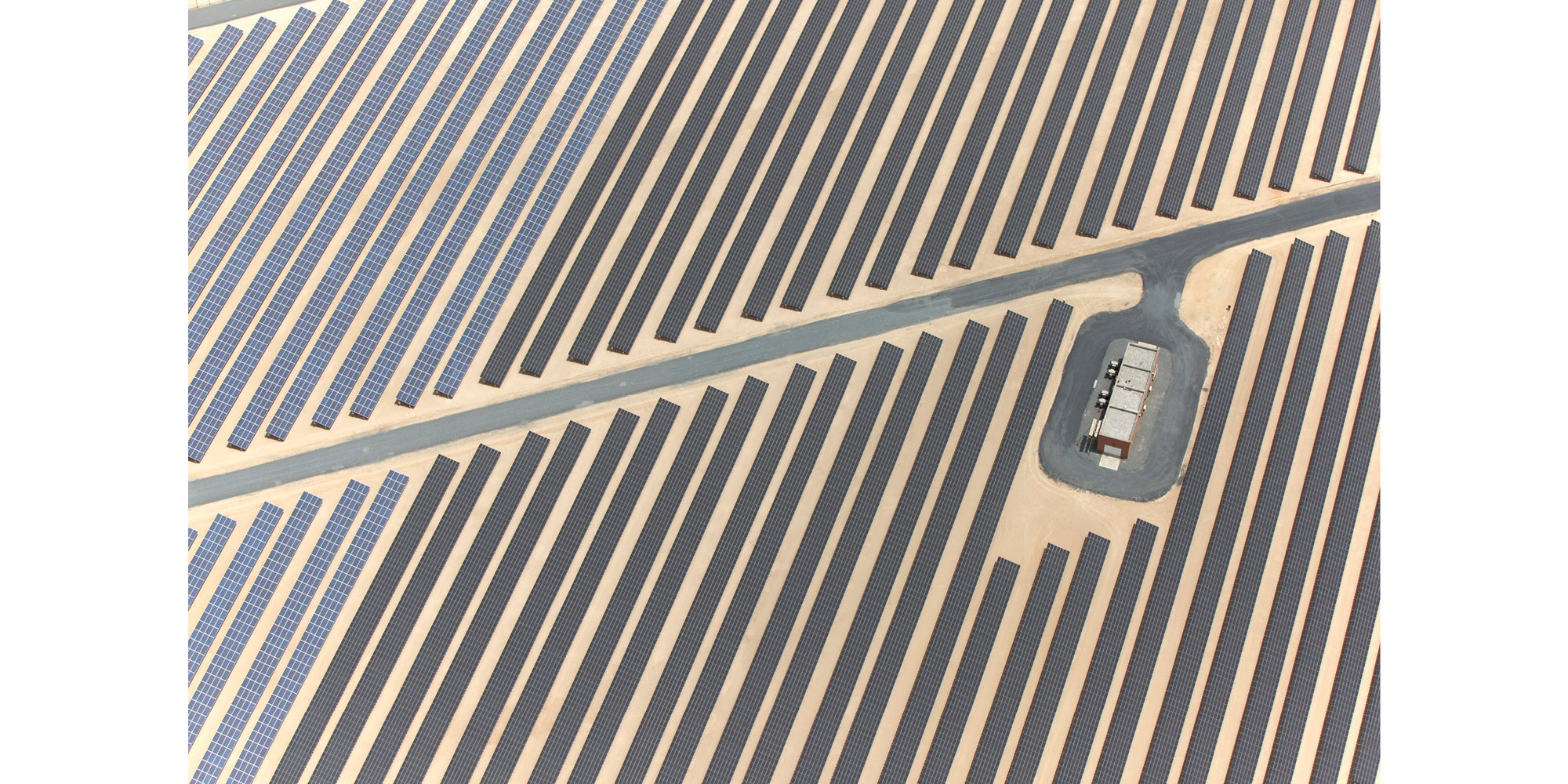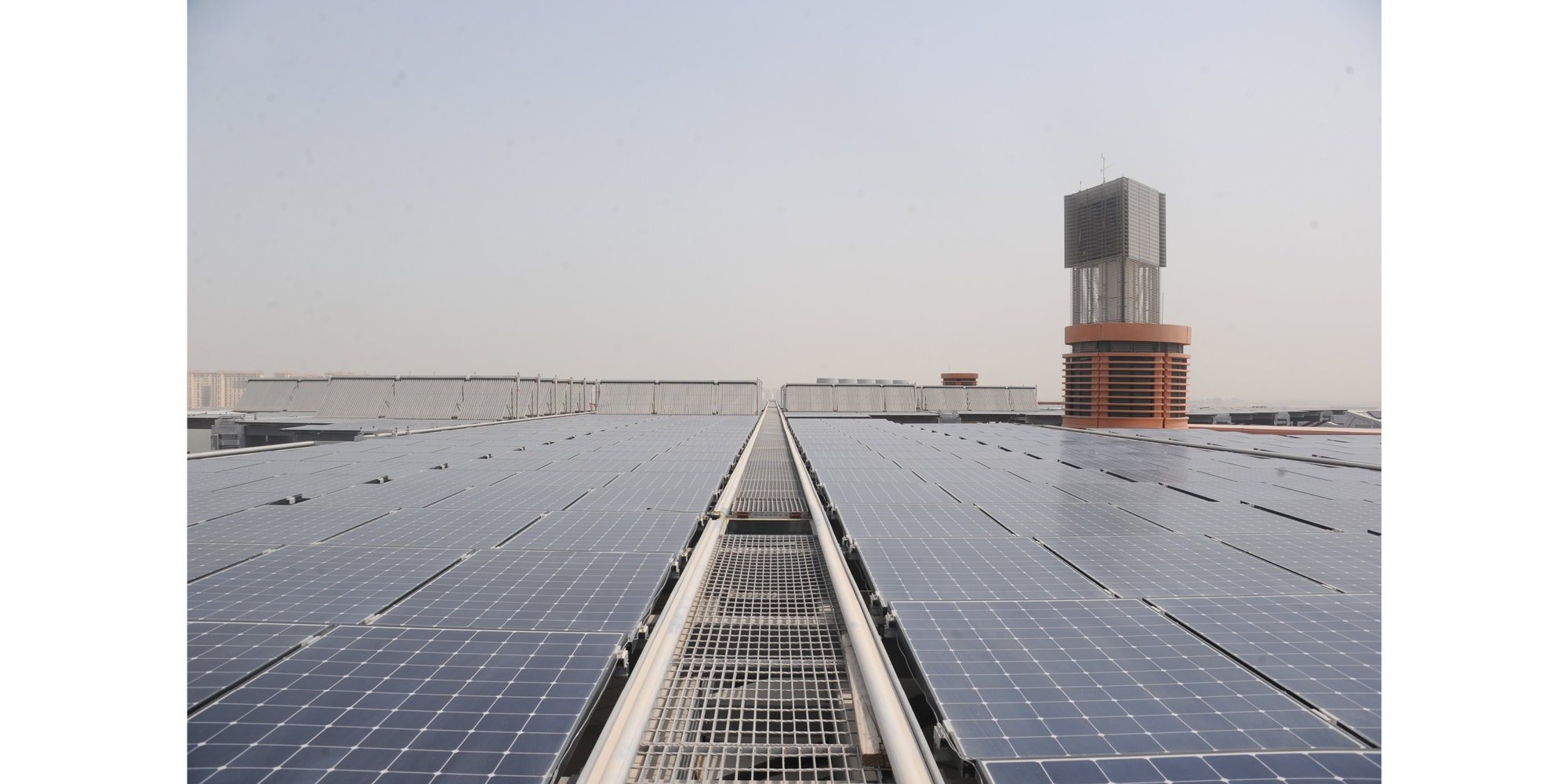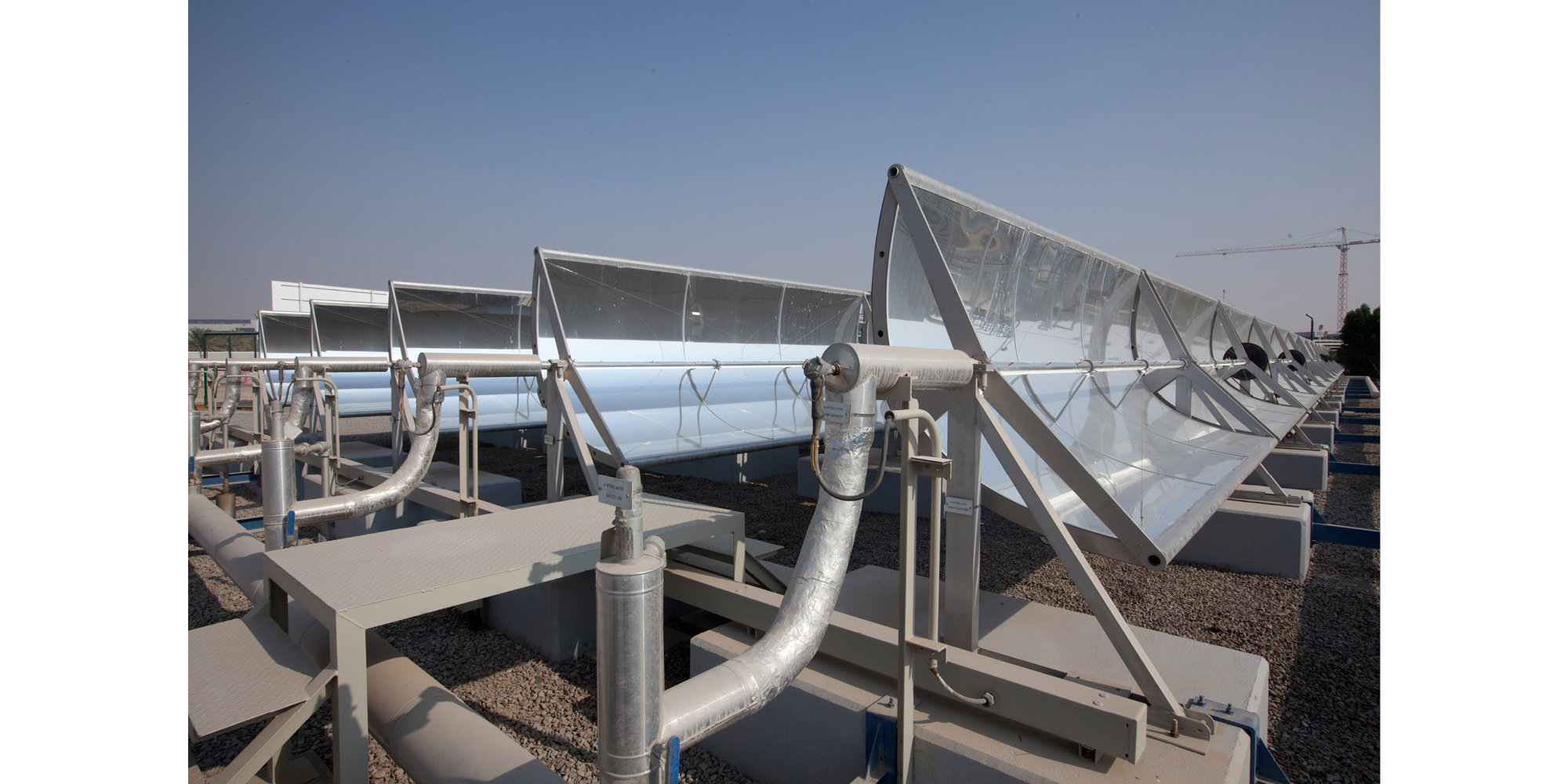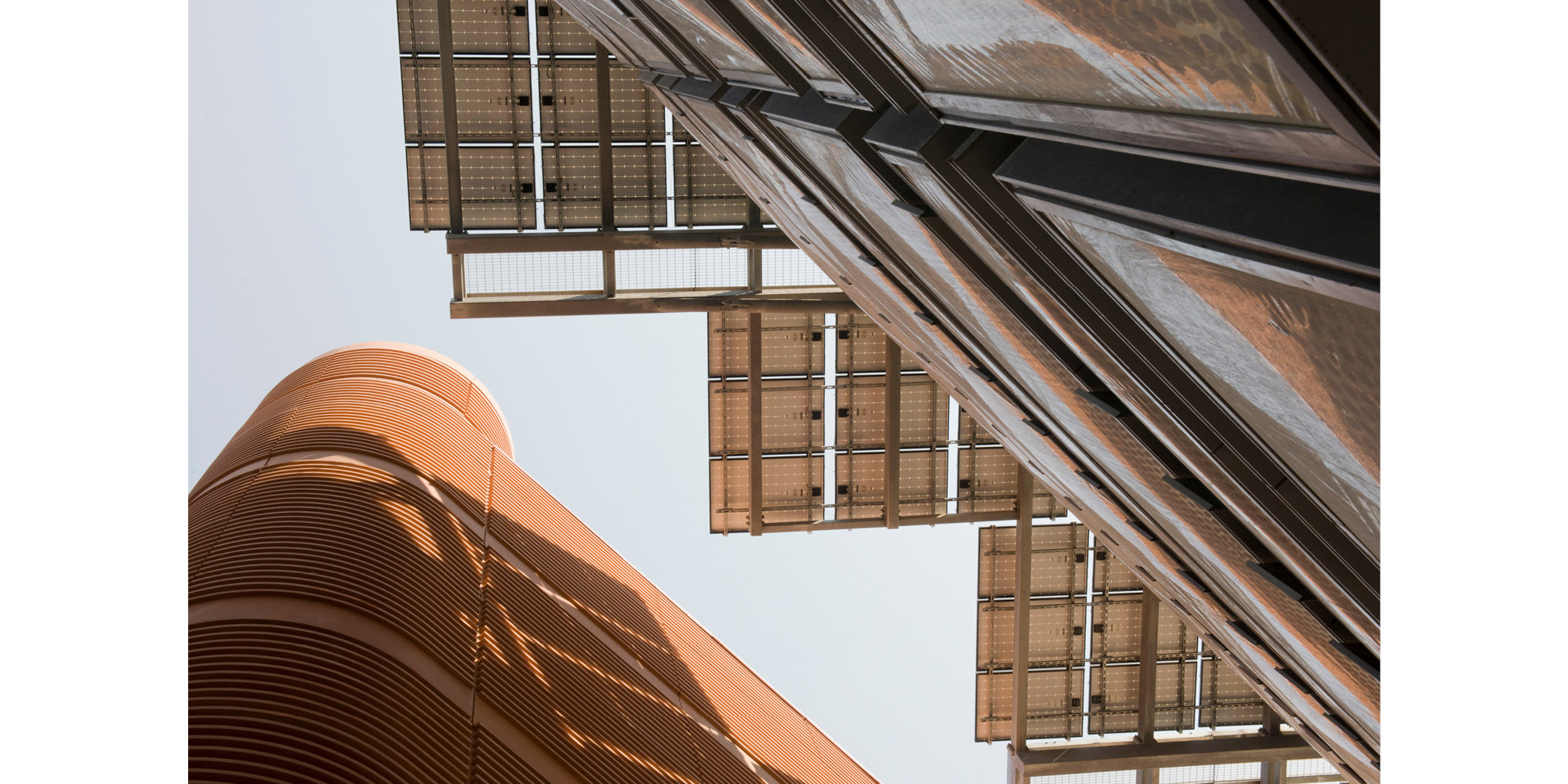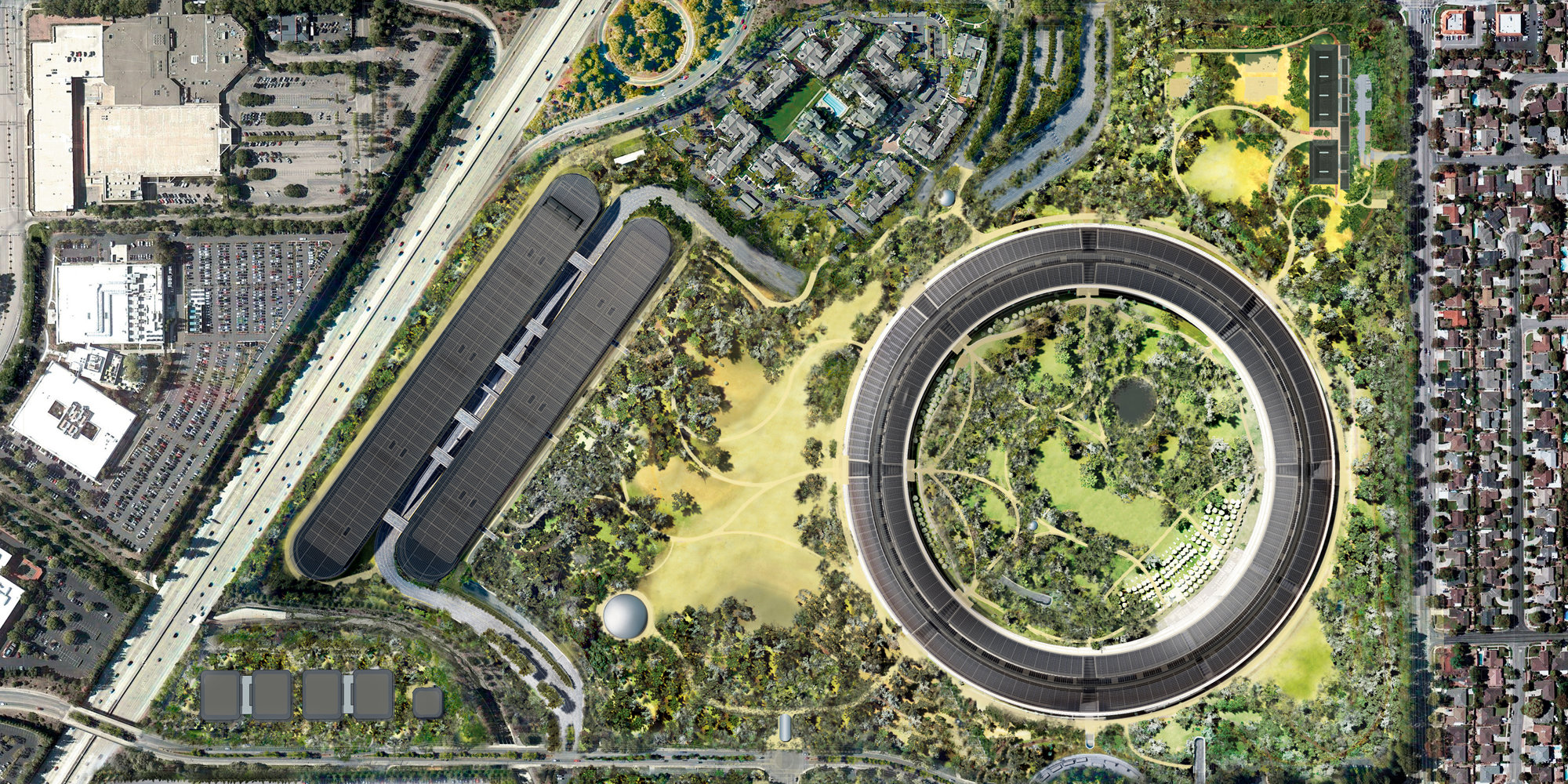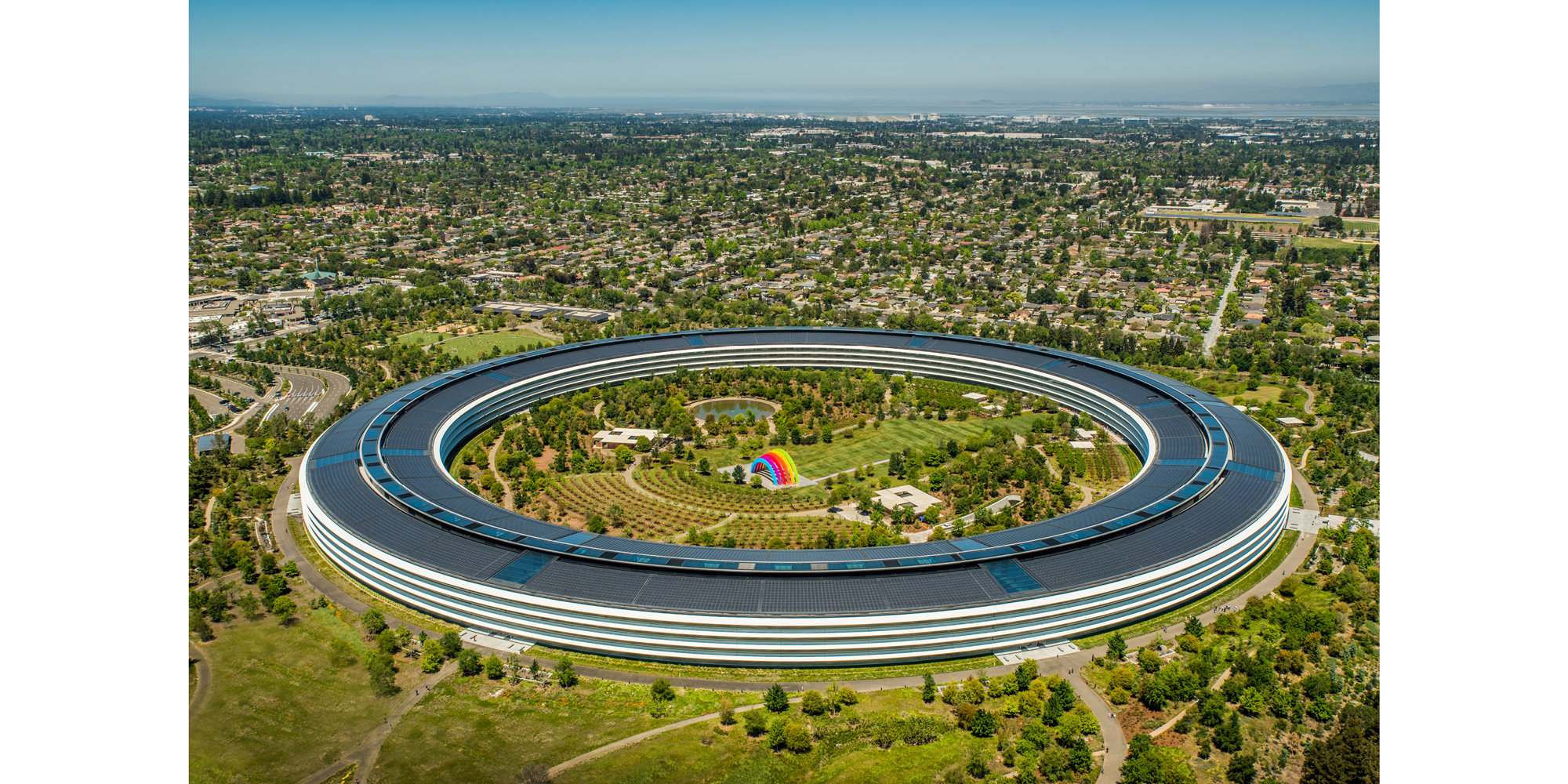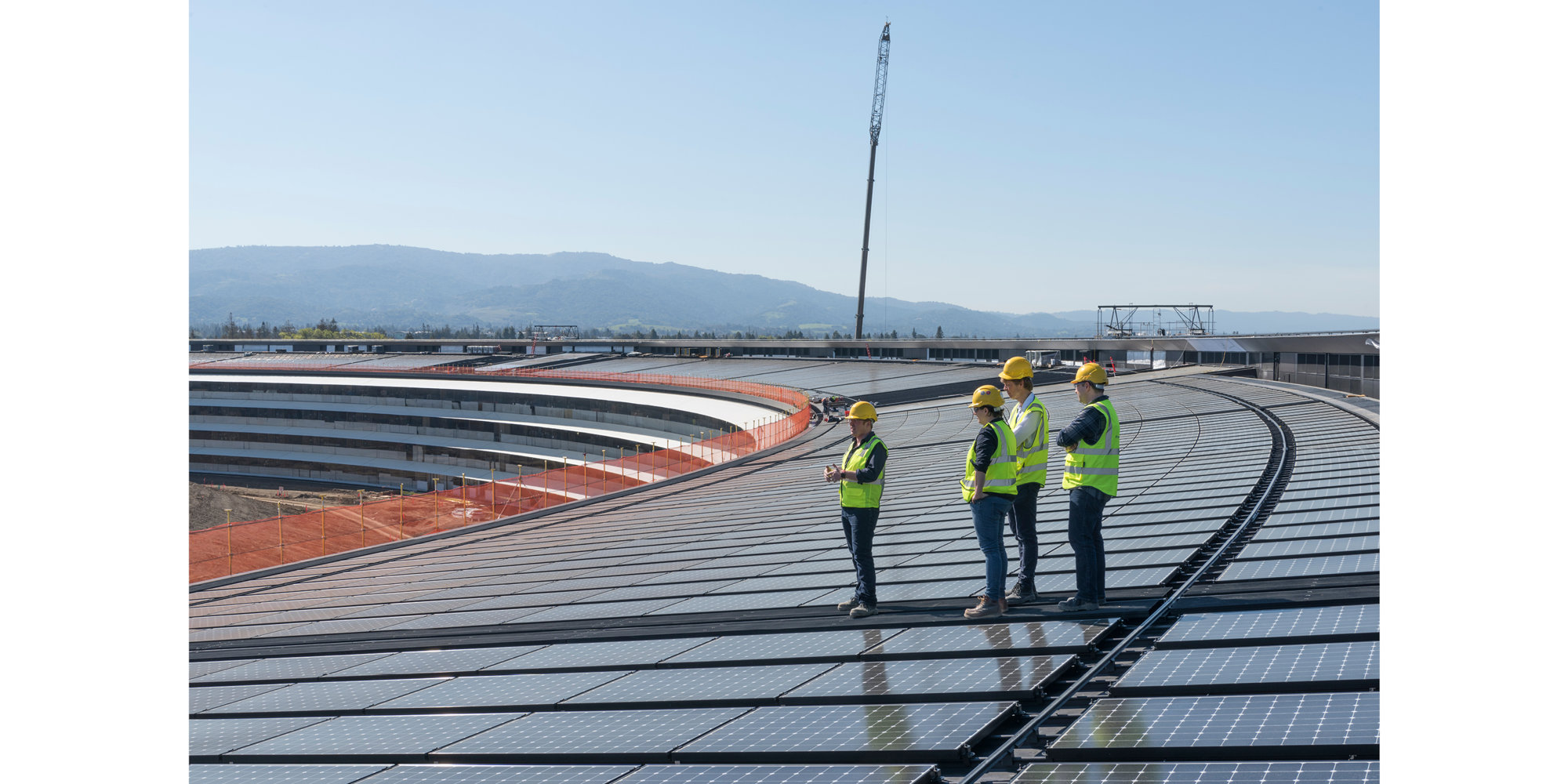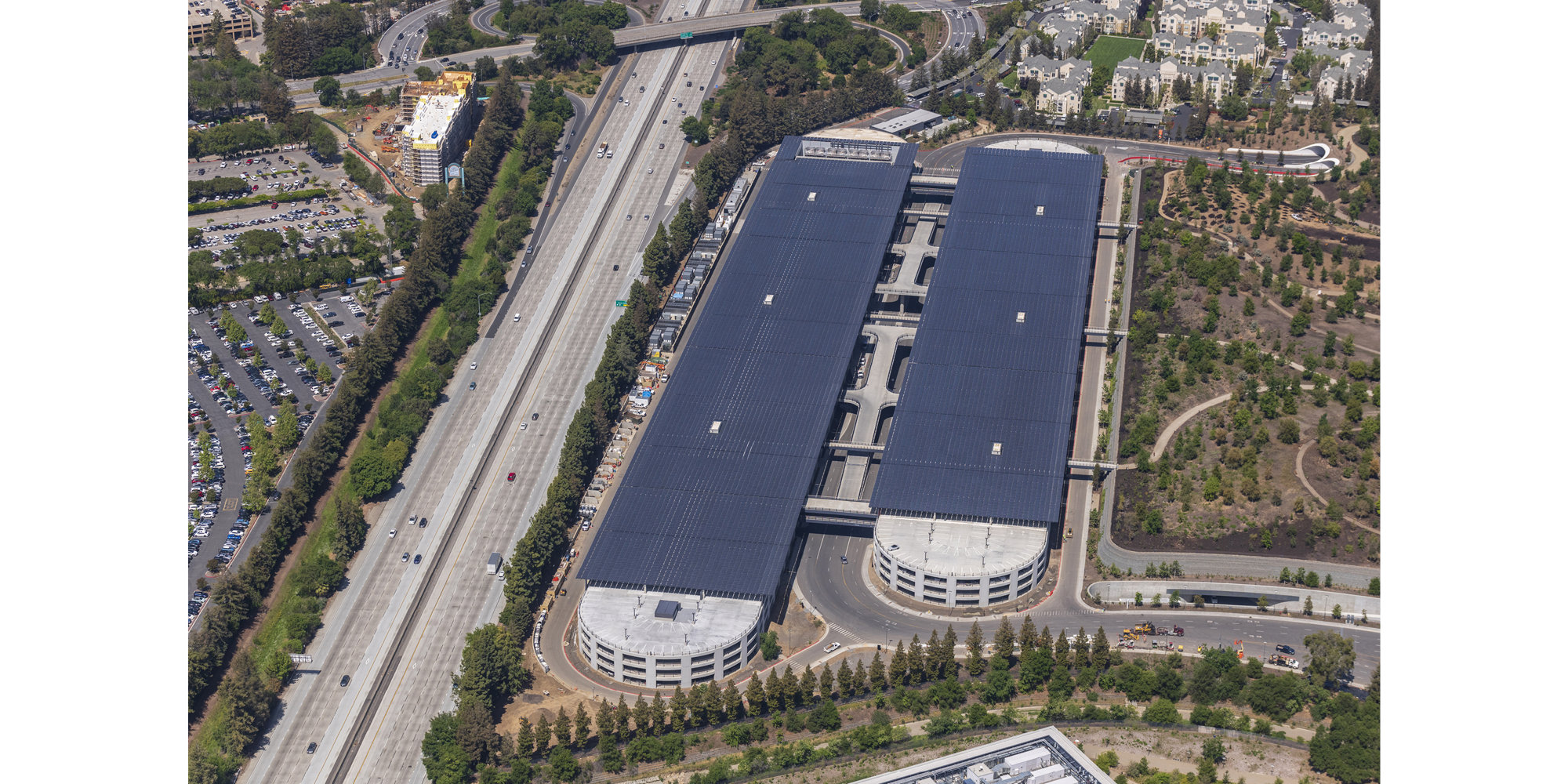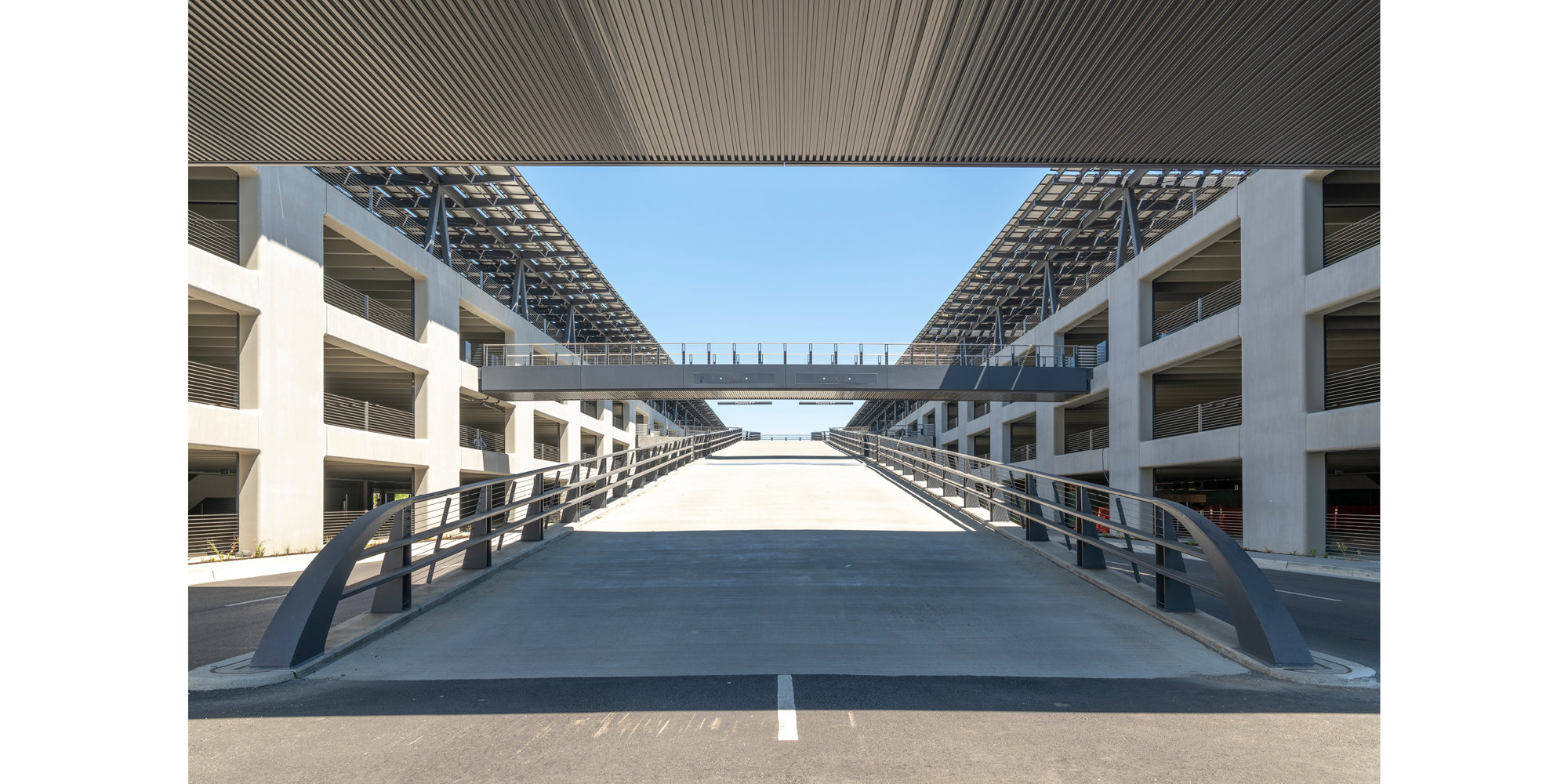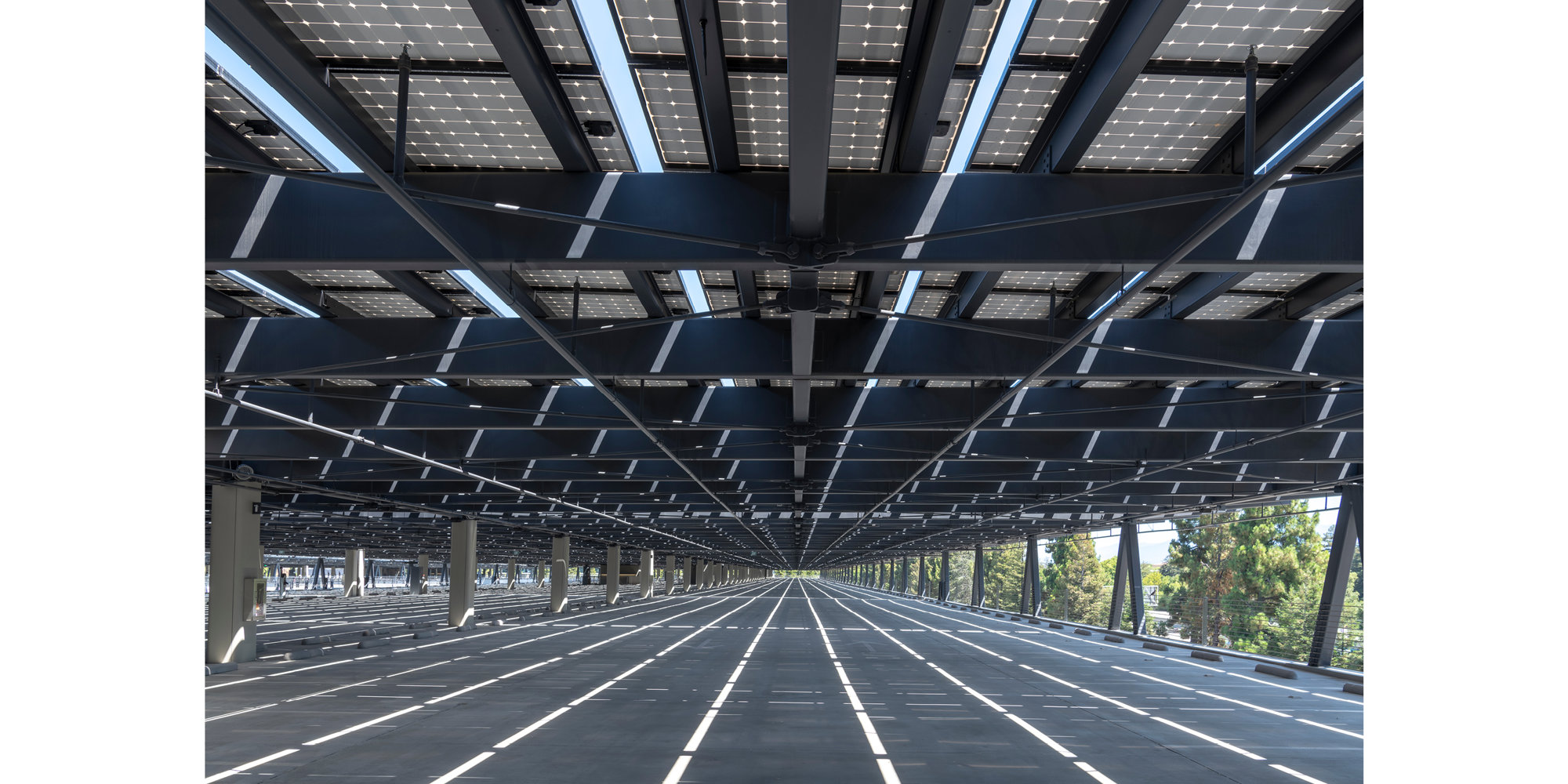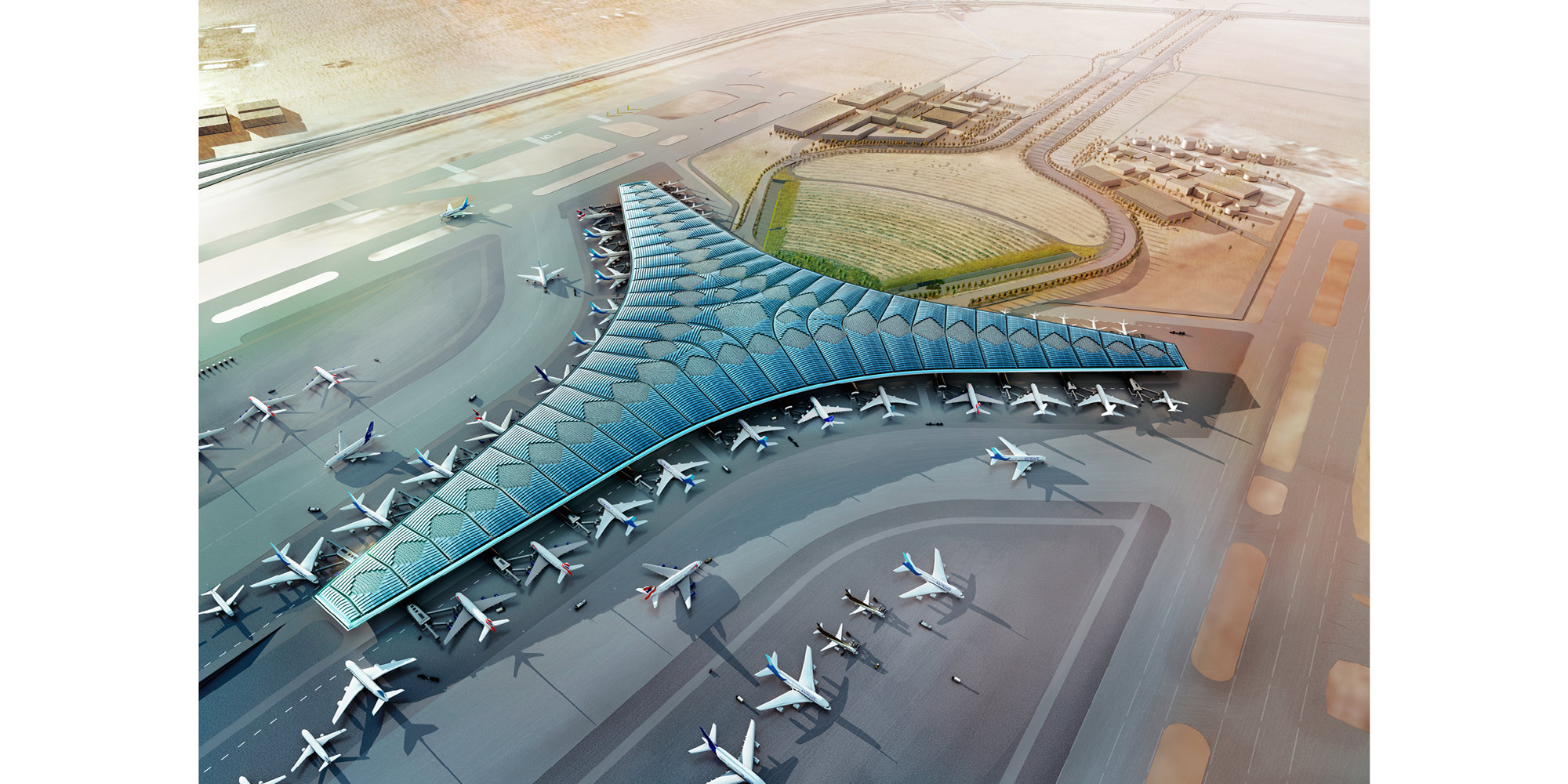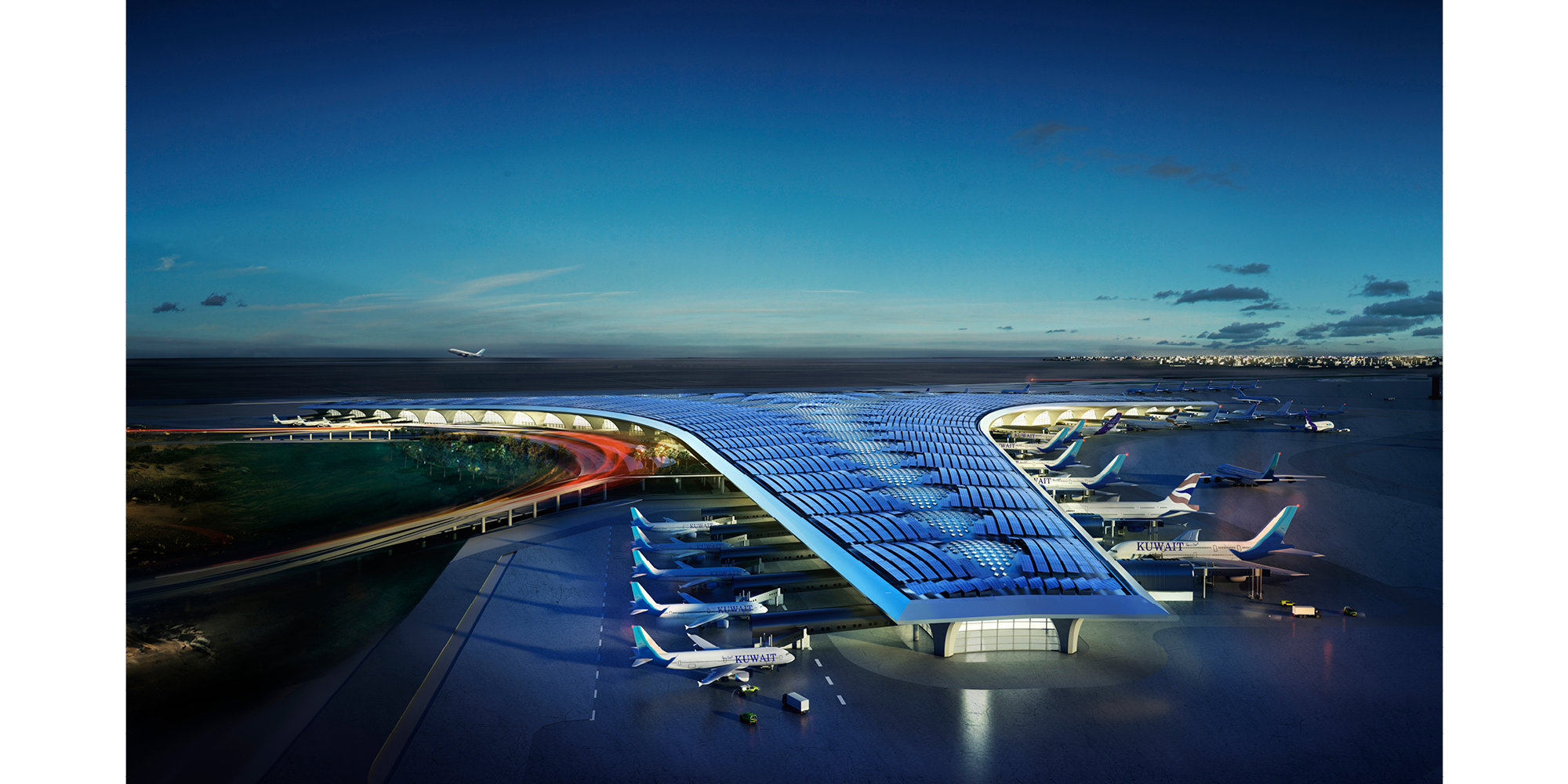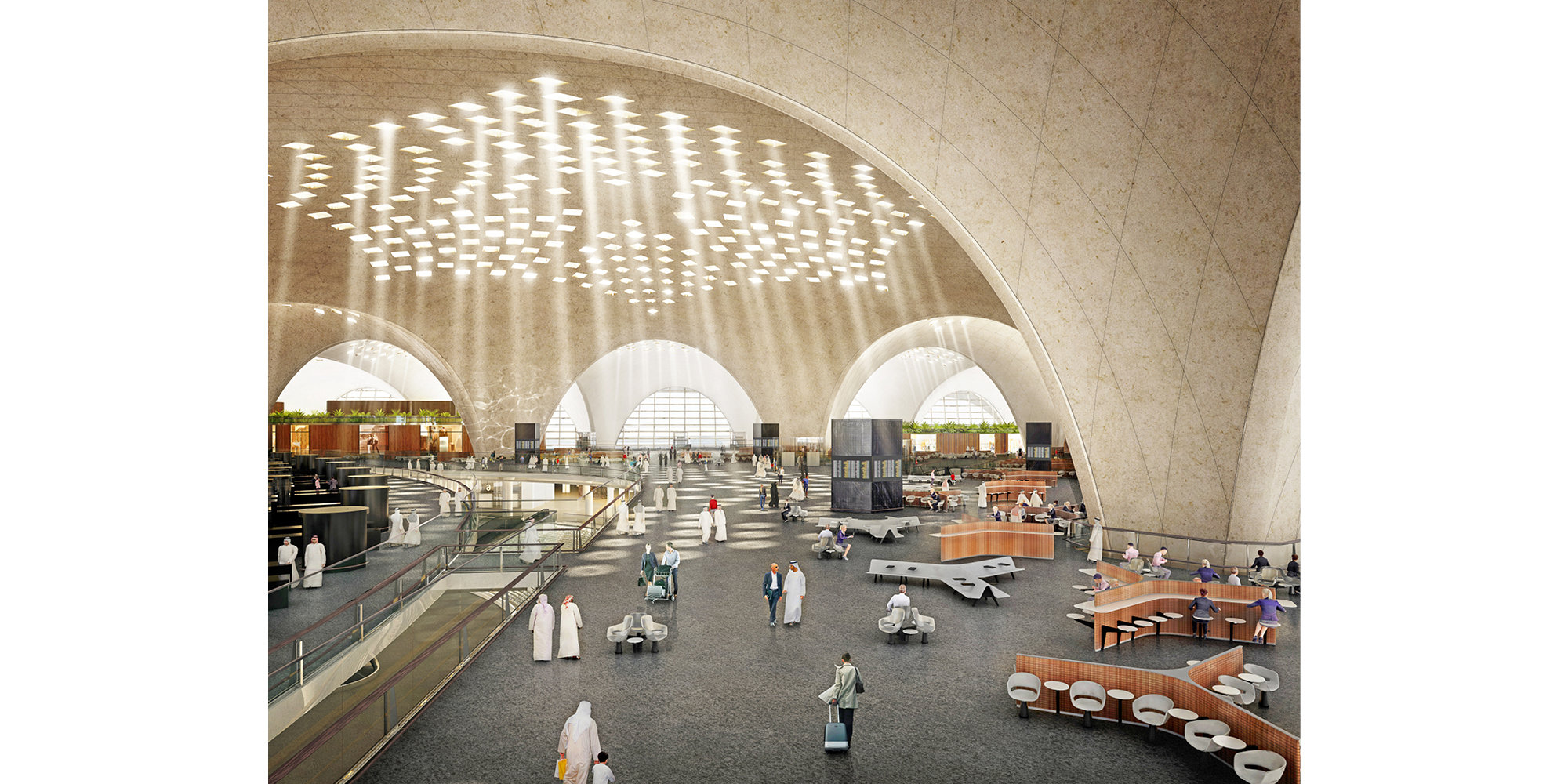As architects confront the climate crisis, integrating renewable energy into buildings has become a defining challenge. This article explores how Foster + Partners has engaged with solar power across decades of practice, tracing its architectural potential and symbolic role. Photovoltaics, with their flexible scale and modularity, can be embedded into facades, roofs and even urban plans – yet always as part of a broader renewable mix, showing how solar sits within a holistic vision of sustainable design.
17th September 2025
Solar Power: Photovoltaics in Architectural and Urban Planning
The shared, sustainable aspects of architecture have always driven the work of the practice. Technology – whether employed at Reliance Controls in 1967 or Apple Park in 2017 – is a means to more social ends. Integration brought function, structure, services and production methods together, to bring democracy to previously segregated spaces and environmental improvements to once-closed systems.
In 2027, Foster + Partners will complete its sixth decade. Reflecting on an era that saw a continued drive for innovation alongside consistent design rigour, we are careful to balance the technical with the sensibilities of the users who, alongside performance, are central to our work.
This experience has also given us a unique perspective on the unfolding climate crisis. We know that relying on a technology-focused, consumption-reduction approach is not enough. It must be combined with an architecture rooted in the needs of people and planet – material and spiritual, measurable and intangible – and that promotes healthy, connected and socially fulfilling lifestyles.
We continue to evolve and have recently undertaken some of our most ambitious works. They consolidate much of what has been achieved but also provide a datum for progress and benchmark new standards of sustainability, placemaking and human wellbeing. These common concerns can result in contrasting schemes, reflecting context, climate and custom. But each is the product of the same levels of exploratory research, technical expertise and formal refinement.
Leading-edge ideas and technology are fused with inspiration from tradition to root the designs, and their users, in place and history. At Masdar, in Abu Dhabi (2015), the new city quarter recreates in contemporary – and sustainable – form some of the essential character of historic Arab settlements. Bloomberg’s headquarters (2017) – in what was London’s Roman heart – adopts the stone solidity of its neighbouring buildings and reinstates part of a lost Roman road. Apple Park restores a vanishing Californian landscape of orchards and oak savannah and, alongside Bloomberg, achieves extensive natural ventilation in a deep-plan workplace – just one facet of environmental design we know to greatly benefit our health and wellbeing.
These projects are milestones in responsible, technical and sustainable design that respond to and revitalise their places. Yet, they are only steps towards even higher standards, as Foster + Partners explores an ever-widening range of ideas in service of human, civic and planetary wellbeing. They are also, perhaps not coincidentally, all projects that have embraced on-site solar energy as part of their technological – and architectural – toolkit for reducing their environmental impact. To create a reliable grid structure that is prepared for renewable transition, the site of energy generation and storage, such as solar power within the fabric of architecture, must extend beyond the original, centralised grid.
This is not to deny the importance of wind, hydro-electric, geo-thermal or, indeed, nuclear, in the pursuit of clean energy and a reliable grid. Today, Foster + Partners hones and applies its thinking to a variety of projects that greatly vary in scale and energy requirements. Being an international practice, these projects span geographies, climates, and countries, each of which have varying site conditions and infrastructural circumstances and, therefore, a diversity of suitable forms of generation that might be implemented.
The issue, thus, is one of context (especially when we consider the potential for the misuse of renewable infrastructure through the destruction of the natural environment). Multiple clean and reliable sources of energy exist and are rapidly evolving from a technological and safety perspective, especially nuclear fission. Recognising this potential, Foster + Partners are members of the World Nuclear Association.
Evidently, then, it must be early in the design process, that architects and engineers work together and ask what opportunities there are to generate energy on or near a project site. This is best begun by using local climate data – that often spans forty or fifty years – in combination with computer models that can account for climate change.
Is the site windy or sunny? Is there a potential for tidal or wave turbine energy? In all cases, the seasonality of a site must be considered. If a location has good wind potential in January, for example, but excellent solar potential in July, then … ‘generation shifting’ might be suggested, which offers a mixed-modal approach to generating energy. In cases where energy potential from renewable sources is prohibitively low or excessively intermittent to be relied upon entirely, more stable clean generation technologies such as next-generation geothermal can be called upon to provide support. Even the newest small-scale nuclear generators have been considered, depending on project size and time scale. This is about designing in a way that is both site-specific and adaptable to changes in seasonality.
Andreia Guerra Dibb, Partner, Environmental Engineering
From out of this renewable energy tapestry came the opportunity to explore one of its threads – that of solar power – and interrogate how it has been woven into the past, present and future of sustainable architecture globally and at Foster + Partners. We can see how the uniquely flexible geometry and modularity of the photovoltaic panel has made it often the most specified renewable energy source at the architectural or urban scale.
A Solar History
The oil crisis of the 1970s was brilliant news for solar energy. Until then, photovoltaic panels (devices that convert sunlight into electricity) had been side-lined at the experimental, even extra-terrestrial fringes of energy generation. By 1975, however, research and investment meant that the cost of these panels had fallen to under $20 per watt, down from $100 a few years earlier – a trajectory which promised to make solar energy cheaper and therefore more accessible to a wider market. This drop in price excited not only the energy sector but the architectural profession, where the integration of photovoltaics into buildings and urban plans appeared for the first time a real, widespread possibility.
That same decade, photovoltaic panels were installed in remote, off-grid locations and certain bespoke, research-based architectural projects. In 1973, for example, researchers at the University of Delaware, United States, integrated them into a project named Solar One. This was a building which used heat and electricity converted from sunlight, and one of the first of its kind.
Solar-powered Gossamer Penguin, piloted by Janice Brown (1948–), in flight at NASA’s Dryden Flight Research Center on July 25, 1979.
The Vanguard TV3 satellite in 1958. Managed by the US Naval Research Laboratory, it carried two radio transmitters, one battery powered and one solar powered, to obtain data on the Earth's shape and gravitational field. It’s launch was a failure and contributed to the establishment of a single civilian space agency, the National Aeronautics and Space Administration (NASA), in 1958.
Foster + Partners was alert to the developments and investments in solar technology taking place throughout the 1970s. In 1975, for example, the young practice completed a regional study for Gomera in the Canary Islands, which proposed several pioneering energy strategies. Energy self-sufficient houses were conceived to be supported by natural resources: wind power generates electricity for lighting and anaerobic generators digest household waste to create methane gas for cooking. The combination of almost constant sunshine and reliable winds on Gomera made the island a perfect testbed for an alternative energy-powered grid – with solar energy, in this case captured to heat water, being a key feature.
A sequence of sketches of the Gomera Case Study by Birkin Haward. The combination of almost constant sunshine and reliable winds made the island a perfect test-bed for alternative energy sources. © Birkin Haward / Foster + Partners
Drawing of a home on Gomera and how it could be supported by natural resources; wind power generates electricity for lighting; sea-water deliveries allow drinking water to be distilled in solar stills; and anaerobic generators digest household waste to create methane gas for cooking. © Birkin Haward / Foster + Partners
It can take many years between investment in the research and development of a new technology and its widespread adoption to take hold. This was the case for photovoltaic technology, where barriers such as unit costs, installation costs, lack of planning incentives, and inefficient energy storage remained limiting factors for the further adoption of solar cells into the built environment.
In the United Kingdom, the first solar panels were installed in 1978 at the Garden House at University of Sussex; and the first domestic solar panels were installed on the Solar Park social housing in Woking, Surrey in 1986. But it wasn’t until 1994 that panels were connected to the national grid, in the ‘Autonomous House’ by Brenda Vale. A year later, in 1995, the Oxford Ecohouse, built by Professor Sue Roaf, became the first home in the United Kingdom with a fully integrated solar roof that connected with the grid. Though a bold and hopeful articulation of the future of energy-efficient homes in Britain, the Ecohouse was nevertheless still limited in its accessibility. The roof cost £28,000 (approximately £58,300 today) – an expensive option for a regular homeowner – and was largely paid for by a supporting solar cell company. Twenty years after their introduction to the market in the 1970s, interest in photovoltaics had gradually broadened. Efforts to subsidise this technology and introduce it in a civic capacity were undertaken most notably in Germany.
The Reichstag’s Solar Vision: Photovoltaic roofs, the European Commission, and drafts for the Solar City
In 1992, Foster + Partners were commissioned to design the Reichstag in Berlin. Following a set of high-profile international competitions, the practice was commissioned for a design that would later be completed in 1999 (after the former building had been Wrapped by Christo and Jeanne-Claude in 1995).
The Reichstag was not only a monumental restoration and renovation task; it was a civic project that needed to represent a reunified Germany in the wake of a painful twentieth century. More so, as the new house for the Bundestag (German parliament), the building needed to look ahead to the twenty-first century, embracing its future technologies and philosophy of democratic leadership. Its transformation is rooted in four major issues: a belief in the significance of the Bundestag as one of the world’s great demographic forums; a determination to make the process of government more accessible; an understanding of history as a force which shapes buildings as well as the life of nations; and a passionate commitment to the low-energy, environment-friendly agenda which is fundamental to the architecture of the future.
The design team – Foster + Partners, Kaiser Bautechnik and Kühn Bauer und Partner, in conjunction with the German Federal Government – developed the brief for an energy efficient building. This was supported by The European Commission, a body supported and contributed financially towards this challenge to create a model for a more sustainable architecture. A dramatically different architectural project than the smaller-scale, speculative research proposals of the Ecohouse, Solar One, or the Garden House, the Reichstag offered its designers an opportunity to bring photovoltaic technology to an international stage. These ideas converged in a structure that combines the manifestation of a German democratic government (which is world-leading in its legislation concerning environmental protection) and the potential for a sustainable, environmentally responsible public building.
Photovoltaic cells, contained within 100 solar panel modules, were installed on the roof. The energy that these cells generate – approximately 40kW at peak output – is then harnessed to drive the exhaust air ventilation system in the public chamber (where the Bundestag sits).
The Reichstag’s roof and glass dome is open to the public as an enactment of an egalitarian and democratic political process. One consequence of introducing the public to the roof is that these solar panels were made as visible as the political processes of the Bundestag; the engineering of the building and its endorsement of a solar architecture are, therefore, celebrated and made explicit, becoming an integrated architectural feature as well as a political endorsement for renewable energy.
At that time, programmes for a more widespread, lower-cost form of solar architecture were also being explored in Germany and the European Union. Political figures such as Hermann Scheer – following a subsidy programme set up by Walter Sandtner, Division Head for Renewable Energies in 1989 – introduced the ‘100,000 Roofs Programme’ (100.000-Dächer-Programm), which aimed to build 100,000 solar residential roofs in Germany, as well as the ‘Feed In Tariff’ in 1999, which paid residents for the kWhs that their buildings delivered to the grid.
During the design and construction of the Reichstag, and alongside the emerging political support for the integration of photovoltaics into buildings, Foster + Partners also leveraged the support of the European Commission, in collaboration with Wolfgang Palz, to extend the research into the potential of solar energy at an urban scale. In 1995, the study for a ‘Solar Quarter’ on an extensive inner-city site of Regensburg, including the island of Unterer Wöhrd in the Danube, emerged from the newly founded Renewable Energies in Architecture and Design (READ) Group chaired by Norman Foster and the European Commission.
In particular, simulation techniques to study the effects of orientation have proved a most useful tool in quickly understanding the impact of fundamental design decisions. The ability to explore the potential of combined heat and power systems for the clearly defined area of the island have led to an understanding of how buildings can work together. The interest and involvement of specialists in the field of monitoring and control systems has allowed us to explore the potential these rapidly developing technologies can have on the increased efficiency of our cities. Finally, the ability to use new technologies, highlighted by our contact with specialists in the field of bio-technology, in our cities illustrates how we can turn waste into gain.
From Foster + Partners' Solar Quarter application
It was felt that the chosen city should have at least 100,000 inhabitants and should have a rich architectural, urban, social and cultural background. It was also felt that the location in this particular study should not be A greenfield site but rather be a brown/grey site within the existing urban fabric, helping to set a sound basis for a sustainable development.
From Foster + Partners' Solar Quarter application
Alongside Regensburg, a plan for a ‘Solar City’ in Linz, Austria, was also considered. This research focused on how solar technology integration could be achieved within the constraints of a standard social housing budget. The designs also address issues of standardisation in the building module while also allowing for maximum flexibility, to enable modification to suit individual circumstances.
Solar architecture has largely concentrated on individual building components such as solar and photovoltaic panels, sun-shading devices and thermal storage elements. Some advances have been made in integrating these elements into the design of individual buildings and thus reducing their energy requirements. Little research however has been conducted into where solar technology and renewable energies might be applied to a wider urban context beyond individual buildings. Nor do we have a good understanding of how urban form can contribute to a solution in our search for more sustainable development.
From Foster + Partners' Solar Quarter application
The 1995 Solar Quarter and Solar City studies captured much of what the practice has since integrated into its design tools. In 2024, for example, Foster + Partners’ Applied Research + Development group released Cyclops, a freely available design plugin that allows designers to turbocharge ray-tracing simulations that are fundamental for environmental analyses. Cyclops can run environmental analyses that used to take hours, or even days, in a matter of seconds, allowing designers to see the effects of building form and massing on ray tracing (sunlight) in real time. For an architect wanting to integrate photovoltaics into their design, or measure how sunlight works at an urban scale, such tools are essential in optimising sunlight exposure and ascertaining where to place panels and buildings for maximum efficiency and, therefore, improved sustainability.
Integrating photovoltaics in commercial projects: Bishops Square and Bloomberg
At the turn of the century, photovoltaics continued to be incorporated into projects by Foster + Partners – despite a slump in the market caused by investment bubbles in Germany, Italy, and Spain ‘bursting.’ Appointed to the practice in 2001 and completed in 2005, the Bishops Square development in London was, at the time, the largest photovoltaic installation in Europe. The project saved 23 tonnes of CO2 by generating 54,000 kWh annually through photovoltaic panels fitted on the modest but important roof garden.
Five years later, in 2010, the practice was appointed to design the Bloomberg headquarters – also in London. Completed in 2017, Bloomberg’s roof is mounted with photovoltaic panels and a combined heating and cooling power system – which translates to a 35 percent saving in energy consumption when compared to the baseline set by the environmental accreditation BREEAM. Additionally, the project achieved an ‘Outstanding’ rating – with a 99.1 percent score – the highest ever for a major office building at the time of its completion.
Both Bishops Square and Bloomberg prove that commercial buildings can integrate photovoltaic technology relatively straightforwardly onto their roof space, leading to a reduction in carbon-intensive energy consumption that is beneficial not only for sustainability but for operational costs. They also demonstrate how commercial buildings can become leading examples of how photovoltaic technology can be integrated in city life; solar architecture need not be confined to the experimental homes of the 1990s or the global icons of government.
Photovoltaics as an urban strategy: Realising the Masdar Institute
Photovoltaics were a key consideration in powering Masdar City, a masterplan project appointed to Foster + Partners by the Masdar-Abu Dhabi Future Energy Company in 2007. The 640-hectare (1,580-acre) project is a key component of the Masdar Initiative, established by the Government of Abu Dhabi to advance the development of renewable energy and clean-technology solutions for a life beyond oil. The broader city masterplan combines state-of-the-art technologies with the planning principles of traditional Arab settlements to create a desert community that aims to be carbon neutral and zero waste. Solar power was deemed a viable source of energy due to the city’s location in the United Arab Emirates – a country that receives strong-to-intense annual solar radiation for eight to eleven hours a day.
A mixed-use, low-rise, high-density development, Masdar City includes the headquarters for the International Renewable Energy Agency and Masdar Institute. Strategically located for Abu Dhabi’s transport infrastructure, Masdar is linked to neighbouring communities and the international airport by existing road and rail routes. With a maximum distance of 200 metres (656 feet) to the nearest rapid transport links and amenities, the city is designed to encourage walking, while its shaded streets and courtyards offer an attractive pedestrian environment, sheltered from climatic extremes. The land surrounding the city contains wind and photovoltaic farms, research fields and plantations, allowing the community to be entirely energy self-sufficient. Knowledge gained in design development has already aided the formation of Abu Dhabi’s ‘Estidama’ rating system for sustainable building in the region.
Part of this vision had already been realised in the Masdar Institute, a key phase in the development, which primarily completed in 2010. The Institute embodies the principles and goals of Masdar to create a prototypical and sustainable city and is the first district of its kind to be powered entirely by solar energy. The design incorporates a variety of passive and active environmental strategies and will be used as a testbed for the sustainable technologies that will be explored in future Masdar City buildings. Photovoltaic cells were fitted on the roofs of the buildings, and 3,156 solar panels were installed in a solar farm nearby – providing up to 10 megawatts of power to the site.
The Beam-Down Solar Thermal Concentrator at Masdar. Ground-level, reflective heliostats track the path of the sun during the day and continuously reflect and focus its rays towards a central reflector at the top of a tower. This reflector then redirects the light to a lower focal point close to ground level. The system was constructed in Masdar City in 2009 in order to investigate the potential of the unconventional design, which uses ‘Beam-Down’ optics and a heliostat construction is a departure from regular central-receiver solar tower designs. © Nigel Young / Foster + Partners
The Beam-Down Solar Thermal Concentrator at Masdar. Ground-level, reflective heliostats track the path of the sun during the day and continuously reflect and focus its rays towards a central reflector at the top of a tower. This reflector then redirects the light to a lower focal point close to ground level. The system was constructed in Masdar City in 2009 in order to investigate the potential of the unconventional design, which uses ‘Beam-Down’ optics and a heliostat construction is a departure from regular central-receiver solar tower designs. © Nigel Young / Foster + Partners
Vernacular elements were introduced to Masdar’s design, including narrow streets and screens for shading. © Nigel Young / Foster + Partners
While long-lasting and strong solar radiation is excellent for photovoltaics, excessive radiation is not advantageous for people’s wellbeing. In the design of Masdar City, Foster + Partners needed to balance the potential for solar energy with the community’s need for shade and for urban cooling.
Calling upon the lessons of a vernacular architecture from the UAE, which developed architectural forms that could both harness sunlight and minimise its effects, the design team created a low-energy urban cluster by prioritising local climate and concerns and passive design strategies. The Masdar Institute, for example, was built with narrow streets to provide shade for pedestrians, strategically oriented buildings to block hot winds, shaded facades using external screening devices, and thick-walled buildings to enhance thermal mass and store heat. Courtyards are designed to offer shade and allow controlled air movement, and well-shaded water features are integrated to benefit from evaporative cooling which passively reduces ambient temperatures.
The Largest Building-Integrated Photovoltaic Installation: Apple Park
Apple Park, which completed in 2017, is the headquarters of Apple in Cupertino, California. Its design places people at its heart, creating an ideal workplace for continued creativity, innovation and wellbeing. The campus is Californian in spirit: open and connected to nature and the product of a remarkable collaboration between Apple and Foster + Partners.
Aerial visualisation of Apple Park. The simple form of the Ring Building conceals immense expertise and innovation. It comprises a few core elements: communal ‘pod’ spaces for collaboration, private office spaces for concentrated work, and broad, glazed perimeter walkways – featuring the largest sheets of curved glass ever constructed – that allow uninterrupted connection to the landscape. © Foster + Partners
One of the most advanced precast concrete structures in the world, over 4,000 slabs, which span up to 15 metres (48 feet), make up the Ring’s floors. Known as ‘void slabs’, these multi-use elements form the structure and exposed ceiling, incorporate radiant heating and cooling and provide air return. © Steve Proehl / Getty
The landscape and building of Apple Park form a seamless whole: the Ring Building, Steve Jobs Theater, Fitness & Wellness Center, Visitors’ Center and South Parking are all encompassed by flowing parkland that enhances the buildings as places to socialise, exercise and work. Flexible and forward-looking, the architecture sits low amid tall trees and brings the invigorating views and fresh air from the park through its glass facades.
The site draws its energy from the sun with 45,170 solar panels, covering 60,400 square metres (650,000 square feet), fitted across the site – namely atop the Ring Building and the South Parking. As Apple reports, it is ‘now the largest LEED Platinum-certified office building in North America. It is powered by 100 per cent renewable energy from multiple sources, including a 17-megawatt onsite rooftop solar installation and four megawatts of biogas fuel cells, and controlled by a microgrid with battery storage. It also gives clean energy back to the public grid during periods of low occupancy.’
Solar panels under construction on the roof of Apple Park. © Nigel Young / Foster + Partners
Solar panels blend into car parking infrastructure at Apple Park. © Nigel Young / Foster + Partners
On-site batteries were vital, as the storage of energy is equally important as its generation. Though renewable energies, including solar, have become far more efficient and cost-effective technologies over the past decade, they cannot guarantee a constant supply (solar, clearly, only works during daylight hours). Designing in ways that reduce pressure on a national and a local grid as it attempts to transition to renewable power must, therefore, factor in storage systems that can reabsorb and store energy for hours, days, perhaps even weeks. Like the data centres that house our ephemeral ‘cloud’ data, energy storage is built, requiring both materials and spatial planning. As energy demands increase, greater storage capacity must also be increasingly integrated into design.
In addition to its solar aspirations, the 71-hectare (175-acre) Apple Park site – which was previously dominated by impervious surfaces – was transformed into a green space, at an increase from 20 to 80 percent, with over six kilometres (four miles) of walking and jogging trails. There are now over 9,000 trees on site, including indigenous oaks and orchards, as well as meadows, sports fields, terraces and a secluded pond. Counter to the view that solar panels – and their accompanying storage needs – encroach on green space, Apple Park proves that, with careful design, ecological and energetic sustainable planning can co-exist.
Kuwait International Airport: Responding to innovation in photovoltaic technology
Advancements in solar technology were also absorbed into the design story of Kuwait International Airport (KIA), a project commissioned the same year as Apple Park. The airport is planned to significantly increase capacity and establish a new regional air hub in the Gulf – these strategic aims will be matched by a state-of-the-art terminal building that will provide the highest levels of comfort for passengers and will set a new environmental benchmark for airport buildings. Its design is rooted in a sense of place, responsive to the climate of one of the hottest inhabited environments on earth, and inspired by local forms and materials.
The terminal has a trefoil plan, comprising three symmetrical wings of departure gates. Each facade spans 1.2 kilometres (0.75 miles) and all extend from a dramatic 25-metre- (82-foot-) high central space. The terminal balances the enclosure of this vast area with a design that is highly legible at a human scale – for simplicity and ease of use there are few level changes. To further aid orientation, the building is planned under a single roof canopy, punctuated by glazed openings that filter daylight, while deflecting direct solar radiation. The canopy extends to shade a generous entrance plaza and is supported by tapering concrete columns – their fluid, organic forms draw inspiration from the contrast between the solidity of the stone and the shape and movement of Kuwait's traditional dhow sailing boats.
Drawing on the region's culture of hospitality and welcoming guests to Kuwait, the design establishes an elegant and memorable arrival sequence for passengers, which includes a baggage reclaim area surrounded by cooling cascades of water. The design also features a grand new landside access sequence from the south. Close to the building, the landscaping is a lush oasis, with strands of drier planting and species native to the desert climate extending further away from the terminal.
Due to the impressive scope and scale of the project, Foster + Partners developed a design for a roof with 60,000 photovoltaic panels, and 3,000 thermal panels. This would cover an area of 160,000 square metres (1.7 million square feet) – almost twenty football fields – and generate a minimum of 20 gigawatt hours of energy. In the fifteen years since this design submission, the materials, methods, and technology of the panelling proposed have greatly advanced. One core principle of Foster + Partners’ design approach is to anticipate and adapt to these new technical developments. This, combined with other strategies (including the thermal properties of the concrete structure), is part of KIA’s aim to attain LEED GOLD environmental accreditation – one of the first passenger terminal in the world to do so.
The future of solar architecture
In the past twenty years, the price of photovoltaics has dramatically fallen. The international spot price for photovoltaic modules was 22 cents per watt in 2022. It was 12 cents in 2023, and then 9 cents in 2024 – compared with $20 per watt in 1975. This is a 99.55 percent reduction in price, or a 0.45 percent comparable cost to fifty years ago, and the technology is more sophisticated than ever. Today, the price for a complete photovoltaic rooftop system in Europe can be as low as €1,500 ($1,748) per kilowatt. Similarly, battery storage in combination with photovoltaics is now overtaking the battery market for electric vehicles.
This drop in price aligns with a rapid increase in installation. As of 2024, over two terawatts of photovoltaic technology have been installed worldwide – matching the world’s coal-fired capacity. This second terawatt took a little over a year to install after the first terawatt, which was achieved in 2022. It is projected that by 2030, eight terawatts in photovoltaic technology might be installed worldwide. This would mean that solar power could generate a significant portion of our global power supply.
The construction industry is responsible for 37 percent of global greenhouse-gas emissions. To move forward in line with climate goals, buildings and infrastructure need to be more efficient and sustainable in both their construction and operation. They must also provide people with the healthiest and most pleasant environment possible. Undeniably, the energy that is needed to achieve this should come from renewable sources.
Solar energy’s dramatic fall in cost and rise in efficiency makes it an essential tool, but never the only one. As Foster + Partners’ work shows, solar must be understood within a wider tapestry of renewable solutions, always designed in response to people, place and climate.
At the same time, progress in nuclear energy, for example (particularly the emergence of small modular reactors, microreactors and even nuclear batteries) is reshaping the landscape of reliable clean power. Foster + Partners, as members of the World Nuclear Association, actively follow these developments, recognising the role such technologies could play in stabilising grids and supporting renewables. Unlike photovoltaics, nuclear is not (yet) directly architectural, but its potential at a more compact scale and offer of safe, distributed deployment, creates new opportunities for integration at the level of towns, cities and large urban developments.
The future will not be defined by a single technology but by the intelligent interplay of many: photovoltaics embedded in facades and rooftops, wind and geothermal systems harnessed where the site allows, and new forms of nuclear supporting stability and resilience. Not to mention the need to continually evolve our understanding of embodied carbon in construction, and life-cycle carbon in the operation of our architecture and infrastructure. For architects, the task is to shape these forces into environments that answer not just technical needs but human ones. In this sense, solar is a reminder that sustainability must be both measurable and intangible – rooted in material performance yet also in the qualities of life, connection and wellbeing that buildings can nurture.
Author
Stefan Behling
Author Bio
Professor Stefan Behling is a Head of Studio, member of the Design Board and was responsible for 'Integrated Design and Innovative Construction' at the University of Stuttgart from 1995 to 2010. He is a passionate advocate for sustainable design, renewable energy and solar energy and has written a book called Sol Power: the Evolution of Sustainable Design with Sophia Behling in 1996.
In his early career, he worked on the Reichstag, the new German Parliament in Berlin, the Commerzbank Headquarters in Frankfurt, multiple projects in Duisburg, the Free University, Berlin, the Lenbachhaus in Munich, and the McLaren Technology Centre in Woking. Stefan has since been responsible for several international projects with a wide range of scale: from masterplans to skyscrapers, airports, and exclusive private homes. A few highlights include: Apple Park in Cupertino, a large portfolio of Apple stores around the world, headquarters for Apple and Bloomberg in London, which won the Stirling Prize in 2018, Kuwait International Airport and Techo International Airport in Cambodia and many luxury resorts in the Kingdom of Saudi Arabia. Besides a core team of architects in London, he is also responsible for international offices in Kuwait and San Francisco.
Editors
Tom Wright and Clare St George
